Page Not Found

Page not found. Your pixels are in another canvas.
A list of all the posts and pages found on the site. For you robots out there is an XML version available for digesting as well.

Page not found. Your pixels are in another canvas.

About me

This is a page not in th emain menu
Published:

Published:

线性二次型调节器(Linear quadratic regulator, LQR)是一种经典的最优控制方法,旨在对线性系统设计状态反馈控制律,使系统在满足稳定性的前提下最小化一个包含状态和控制输入加权的性能指标函数。通过求解代数黎卡提(Riccati)方程,LQR 可以系统地权衡控制性能与能耗,实现稳健、平滑的系统响应,广泛应用于自动控制和现代控制系统设计中。
Published:

线性回归(linear regression)是利用称为线性回归方程的最小平方函数对一个或多个自变量和因变量之间关系进行建模的一种回归分析。这种函数是一个或多个称为回归系数(Regression Coefficients)的模型参数的线性组合。
Published:

Short description of portfolio item number 2 
Published:

Short description of portfolio item number 2 
Published:

Short description of portfolio item number 2 
Published:

Short description of portfolio item number 2 
Published:

Short description of portfolio item number 1
Published:

Short description of portfolio item number 2 
Published in IEEE Transactions on Sustainable Energy, January 2, 2014 [FullText]
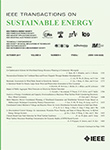
A simplified adiabatic model of the Stirling engine is developed for the study of a grid-connected dish-Stirling solar-thermal power plant. The model relates the average values of the engine state variables and also takes into account the engine losses. As the engine is shown to exhibit nonminimum phase behavior, an improved temperature control scheme for the engine heat absorber is developed. By including the engine speed, pressure, and solar insolation limits into the analysis, a steady-state feasible operating regime of the solar-thermal power plant is obtained. A maximum solar energy harness is shown to be achievable through the variable speed operation of the power plant.
Published in IEEE Transactions on Energy Conversion, September 23, 2014 [FullText]
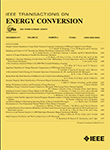
Analysis on a developed dynamic model of the dish-Stirling (DS) system shows that maximum solar energy harness can be realized through controlling the Stirling engine speed. Toward this end, a control scheme is proposed for the doubly fed induction generator coupled to the DS system, as a means to achieve maximum power point tracking as the solar insolation level varies. Furthermore, the adopted fuzzy supervisory control technique is shown to be effective in controlling the temperature of the receiver in the DS system as the speed changes. Simulation results and experimental measurements validate the maximum energy harness ability of the proposed variable-speed DS solar–thermal system.
Published in IEEE Transactions on Power Systems, July 11, 2017 [FullText]
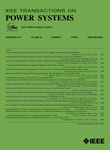
The ability of an induction generator-based dish-Stirling (DS) solar–thermal power plant in providing primary frequency control is examined. A dynamic model of the power plant is developed, in which the receiver/absorber temperature of the Stirling engine is allowed to vary. Primary frequency control is achieved through the adaptive regulation of the receiver temperature set-point and the droop setting of the output power–temperature characteristics of the DS system. However, the penetration level of the solar–thermal generation into the grid system has to be constrained to avoid the onset of instability due to the nonminimum phase characteristics of the DS system. The transient droop compensation technique is then proposed to alleviate the instability issue and results in an increase in the allowable DS penetration level.
Published in Journal of the Electrochemical Society, May 9, 2018 [FullText]
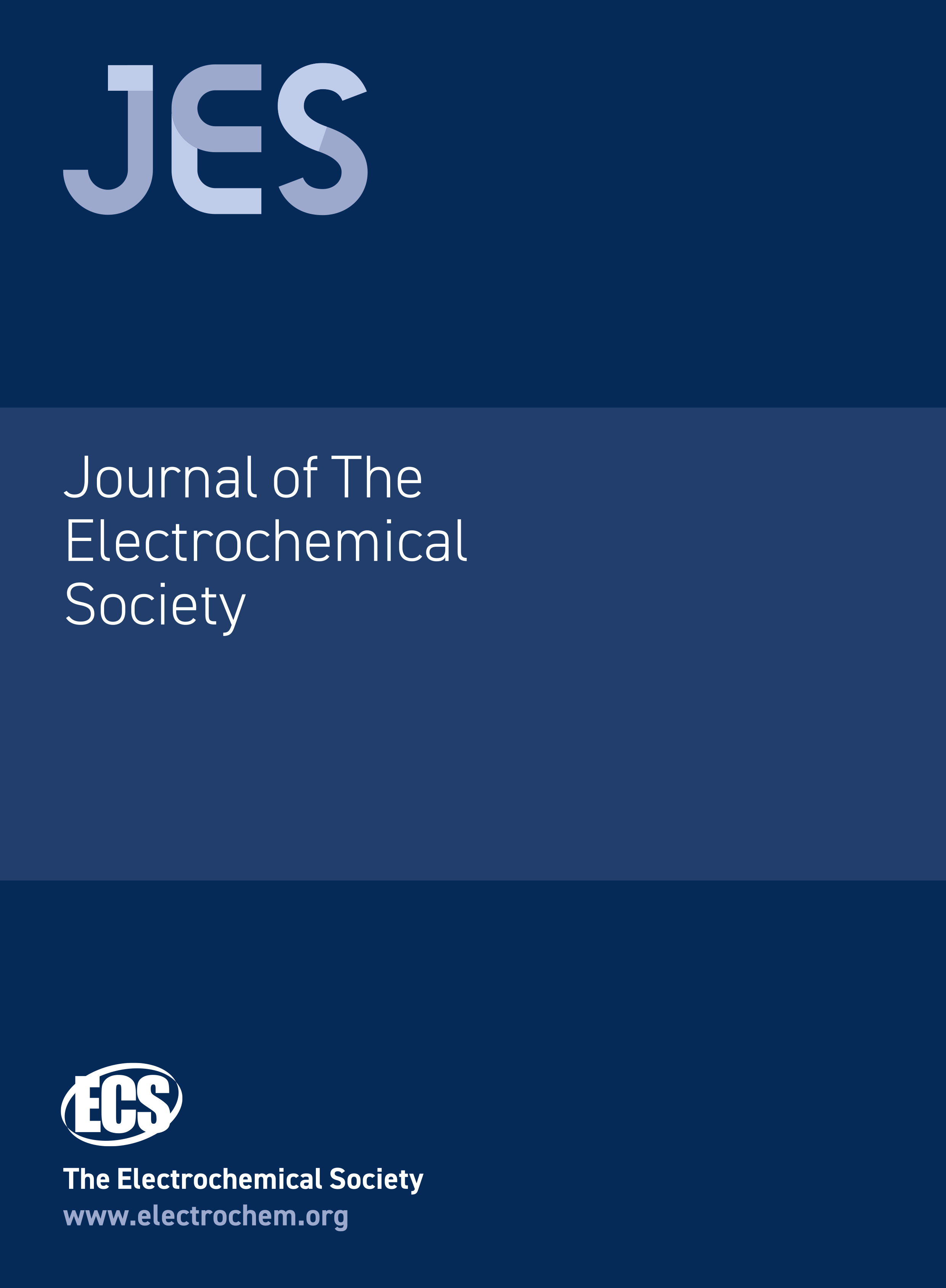
We present a reduced order model for a lithium ion battery in which Padé approximants are used to simplify complex, transcendental, transfer functions associated with the linearized, pseudo 2-dimensional (P2D) electrochemical model of the battery. The resulting transfer functions take the form of simple, rational polynomial functions, which can be used to compute any variable at any location within a one-dimensional representation of the battery domain. Corrections for nonlinear behavior are also incorporated into the reduced model. The results obtained using the reduced model compare favorably to those from the full (nonlinear) P2D model and the computational time required to produce these results is significantly reduced. Importantly, the form of the reduced model means that variables can be evaluated at specific discrete locations within the cell domain, without the need to compute all values of the variable at all discrete locations, as is the case with the spatial discretization methods most commonly used to implement the P2D model. We show that this results in further significant time savings and enhances the suitability of the model for variety of applications.
Published in Electrochimica Acta, January 4, 2019 [FullText]
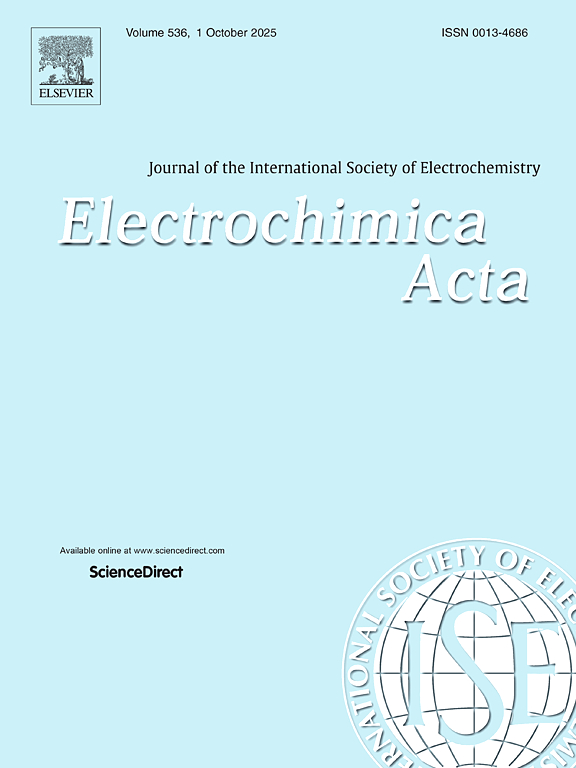
A physics-based equivalent circuit model (ECM) is derived by applying finite volume method to a pseudo-two-dimensional (P2D) model of lithium-ion (Li-ion) batteries. Only standard passive components are used to construct the equivalent circuit, which reflects the fact that a Li-ion battery is an energy storage device. Voltages across and currents through the circuit elements in the ECM are identified with the respective internal electrochemical processes in the battery, thus allowing the parametric values of circuit elements to be expressed as functions of the Li-ion concentrations and temperature. Variations in the parametric values across the thickness of the battery leads to a distributed-parameter ECM amenable for wide range of applications. Furthermore, in contrast to existing reduced-order models of Li-ion battery which are described by differential algebraic equations, the ECM is governed by ordinary different equations wherein all the circuit components are expressed as explicit functions of the state and input variables. Hence, the developed model allows solution to be found directly using matrix algebra, resulting in rapid simulation study suitable for the development of computationally-efficient real-time battery control algorithm. Results of simulation based on the developed distributed-parameter ECM show close agreement with those obtained from a partial differential equation based P2D model under wide range of applied current rate, but at a much reduced computational burden.
Published in IET Power Electronics, March 6, 2019 [FullText]

This study presents a high step-up scalable voltage multiple cell (SVMC)-based DC/DC converters, which have the features of high gain, low and adjustable components stresses and automatic input-current sharing in each input phase. In virtue of the above features, the converter is applicable for the DC collection grids for offshore wind farms. In this study, the converter in terms of working principle and property characteristics are analysed with four input phases and three SVMCs. The converter has also been evaluated in terms of the component stress and voltage conversion ratio against some other converters for high-power occasions. Moreover, a 2.5 MW simulation model and a 1.2 kW prototype were constructed for verification.
Published in IET Power Electronics, April 1, 2019 [FullText]

A non-isolated high-voltage gain dual-input DC/DC converter with a zero voltage turn-off (ZVT) auxiliary circuit has been presented. Two photovoltaic (PV) modules can be connected to the proposed converter with separate maximum power point tracking (MPPT). The cost of whole PV power generation system can be decreased significantly as a single converter is employed instead of two converters. All switches can achieve ZVT by an auxiliary circuit, and turn-off switching losses can be decreased and the efficiency of the converter can be improved. Working principle and performance characteristics of the proposed converter are analysed in detail, a dual-input maximum power point tracking control algorithm has been designed for the proposed converter. An 800 W experimental prototype has been built to verify the theoretical analysis.
Published in Applied Energy, May 16, 2019 [FullText]
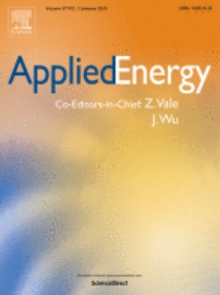
A computationally-efficient and reliable method is developed to permit the simultaneous assessment of both the short- and long-term performance of lithium-ion battery in power system planning studies. Toward this end, a physics-based equivalent circuit model of the lithium-ion battery is derived in which side reaction-induced degradation of the battery is included. Whence a computational procedure is developed to enable the parametric values of the circuit elements in the equivalent circuit model to be automatically updated as the battery operates. The resulting model allows the increase in the internal resistance and the decrease in the energy storage capacity of the battery to be determined, based solely on the information of the power flows at the battery terminals. Dynamic simulation results obtained using the developed equivalent circuit model are shown to be in close agreement with those obtained from well-established electrochemical models, but at a much reduced computational burden.
Published in Journal of the Electrochemical Society, September 11, 2019 [FullText]
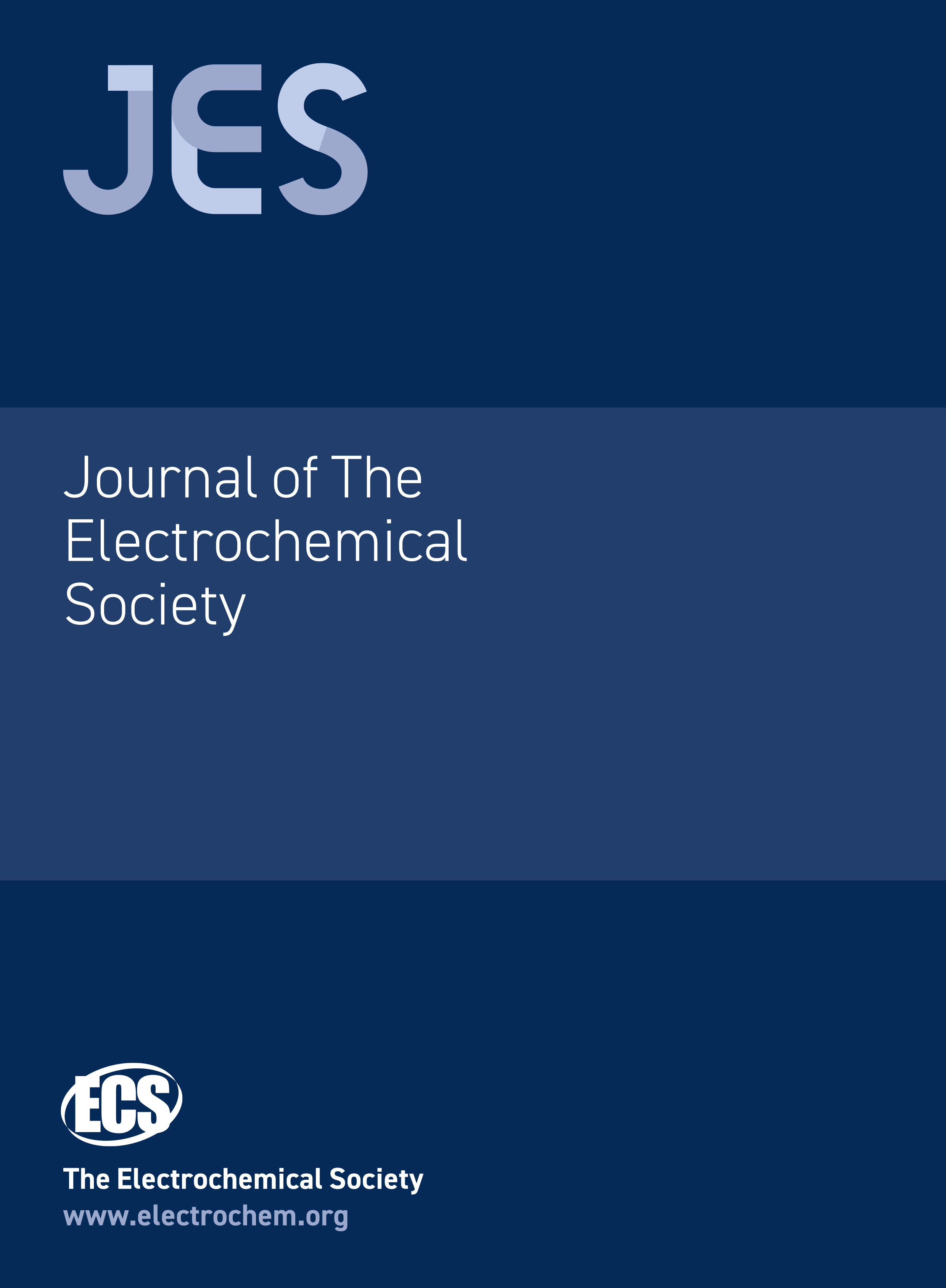
We present a one-dimensional, radial, coupled degradation-electrochemical-thermal (DET) model of a large format cylindrical lithium ion cell. The model consists of reduced order equations that describe the electrochemical phenomena, including that associated with degradation, coupled with an approximate model of thermal behavior. The reduced order electrochemical model, which is approximated from the pseudo-two-dimensional (P2D) electrochemical model using a Padé approximation method, computes the variation of electrochemical variables and heat generation terms. Simultaneously, a coupled thermal model computes the temperature distribution in the radial direction of the cell. The results from DET model compare favorably to those obtained from solving the 1D radial coupled degradation-electrochemical-thermal partial differential equations in COMSOL Multiphysics, however the DET model returns these results in significantly reduced computational times. Importantly, the model capability in providing insightful information of cell degradation and temperature in a computationally efficient manner paves the way for the health-conscious, real-time optimal control of large format cylindrical cells.
Published in IEEE Access, November 7, 2019 [FullText]
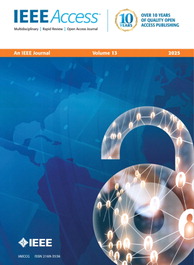
Thermal issue is one of the major concerns for safe, reliable, and efficient operation of the vanadium redox flow battery (VRB) energy storage systems. During the design of the operational strategy for a grid-connected VRB system, a suitable mathematical model is needed to predict the dynamic behaviors under various operating conditions. However, conventional VRB models usually neglect the impact of temperature variations on system performance. This work develops an enhanced VRB model with the consideration of the coupling effects between the electrochemical and the thermal behaviors. The proposed model consists of two equivalent circuits. First, the electrochemical behaviors of the VRB are modeled by a second-order RC network taking account of the effects of concentration variation of the vanadium ions and the electrochemical activation. Second, a third-order Cauer network is used to model the heat transfer process in the VRB system, and the dynamic thermal behaviors of stacks, pipes and heat exchangers are characterized. Well-designed experiments and particle swarm optimization algorithm are use to identify the parametric values of the developed model. The proposed modeling method was validated experimentally using a 5kW/3kWh VRB platform, and the results show that the model is capable of accurately predicting the VRB performance under variable temperature conditions. The developed coupled electro-thermal model is then used for simulating and analyzing the performance of a VRB system operated in conjunction with a wind power plant under real-world conditions.
Published in Applied Energy, December 19, 2019 [FullText]
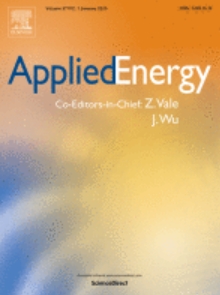
The application of lithium-ion (Li-ion) battery energy storage system (BESS) to achieve the dispatchability of a renewable power plant is examined. By taking into consideration the effects of battery cell degradation evaluated using electrochemical principles, a power flow model (PFM) of the BESS is developed specifically for use in system-level study. The PFM allows the long-term performance and lifetime of the battery be predicted as when the BESS is undertaking the power dispatch control task. Furthermore, a binary mode BESS control scheme is proposed to prevent the possible over-charge/over-discharge of the BESS due to the uncertain renewable input power. Analysis of the resulting new dispatch control scheme shows that a proposed adaptive BESS state of energy controller can guarantee the stability of the dispatch process. A particle swarm optimization algorithm is developed and is incorporated into a computational procedure for which the optimum battery capacity and power rating are determined, through minimizing the capital cost of the BESS plus the penalty cost of violating the dispatch power commitment. Results of numerical examples used to illustrate the proposed design approach show that in order to achieve hourly-constant power dispatchability of a 100-MW wind farm, the minimum-cost Li-ion BESS is rated 31-MW/22.6-MWh.
Published in IEEE Transactions on Industrial Informatics, February 18, 2020 [FullText]
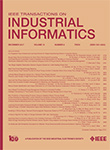
This article proposes a novel model-based estimator for distributed electrochemical states of lithium-ion (Li-ion) batteries. Through systematic simplifications of a high-order electrochemical–thermal coupled model consisting of partial differential-algebraic equations, a reduced-order battery model is obtained, which features an equivalent circuit form and captures local state dynamics of interest inside the battery. Based on the physics-based equivalent circuit model, a constrained ensemble Kalman filter (EnKF) is pertinently designed to detect internal variables, such as the local concentrations, overpotential, and molar flux. To address slow convergence issues due to weak observability of the battery model, the Li-ion’s mass conservation is judiciously considered as a constraint in the estimation algorithm. The estimation performance is comprehensively examined under a wide operating range. It demonstrates that the proposed EnKF-based nonlinear estimator is able to accurately reproduce the physically meaningful state variables at a low computational cost and is significantly superior to its prevalent benchmarks for online applications.
Published in IEEE Access, August 19, 2020 [FullText]
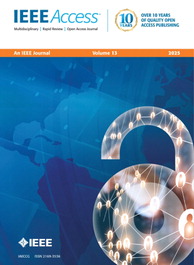
The potential of variable-speed dish-Stirling (VSDS) solar-thermal generating plant in providing grid frequency support is investigated. In the proposed VSDS frequency support control scheme, the reference speed of the Stirling engine is regulated to track a deloaded power curve which is governed by the solar insolation level. The gain of a supplementary speed-frequency droop controller is then set to meet the primary frequency control requirement. Further uniqueness of the VSDS control scheme pertains to the provision of virtual inertia response by regulating the kinetic energy in the rotating mass of the engine-generator and the thermal energy in the heat absorber/receivers. Small-signal analysis shows that the frequency support scheme is inherently stable, and it will provide higher degree of damping as the penetration level of the VSDS system and/or the solar insolation level increase. The efficacy of the proposed scheme is validated by computer simulation.
Published in IEEE Transactions on Sustainable Energy, December 3, 2020 [FullText]
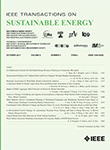
This article addresses the challenging task of developing a procedure for the day-ahead dispatch planning of wind power which emanates from a wide geographical area. Using the complete ensemble empirical mode decomposition technique, it is shown that the low-frequency components of the area aggregated wind power account for the largest proportions of the perturbing energy harnessed from the wind. By taking advantage of the slow-varying characteristics of the low-frequency components, accurate forecast of these components is readily obtained and incorporated into the developed dispatch planning procedure. The dispatchability of the wide-area wind generation is facilitated by the buffering actions offered by a centralized power dispatch energy storage system, operating under a proposed power flows control strategy. The efficacy of the developed procedure is illustrated using a pumped hydroelectric system as the dispatch energy storage medium.
Published in IEEE Transactions on Power Delivery, January 12, 2021 [FullText]
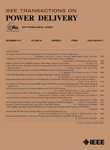
Existing faulted feeder identification methods in the resonant grounded distribution network are primarily based on feature extraction of the fault-generated transient currents. The reliability of these approaches is significantly compromised by the fluctuating transient signals and interfering on-off operation of the neighboring switches. To sidestep the problems, a novel method is proposed to identify the faulted feeder by consecutively tuning the arc suppression coil around the full compensation state. Once a series of steady states are reached after tuning, the trajectories of the corresponding zero-sequence currents for both the sound and the faulted feeders are obtained to formulate an adjustment trajectory matrix (ATM). With the ATM, the similarity measure of the adjustment trajectories of all feeders is then employed to identify the faulted feeder based on the selected Deng’s grey relational analysis. Results show that the adjustment trajectories of the two sound lines share a high similarity degree, while the similarity between the sound and the faulted lines is much lower. The effectiveness of the proposed method is validated via simulation and some case studies are provided. The results show that the faulted feeder can be correctly identified with high reliability and robustness compared to the existing fault-generated signal-based techniques.
Published in IEEE Transactions on Industrial Electronics, March 10, 2021 [FullText]
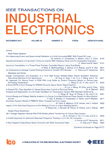
The accurate diagnostic of internal short circuit (ISC) is critical to the safety of lithium-ion battery (LIB), considering its consequence to disastrous thermal runaway. Motivated by this, this paper proposes a novel ISC diagnostic method with a high robustness to measurement disturbances and the capacity fading. Particularly, a multi-state-fusion ISC diagnostic method leveraging polarization dynamics instead of the conventional charge depletion is proposed within a model-switching framework. This is well proven to eliminate the vulnerability of diagnostic to battery aging. Within this framework, the recursive total least squares method with variant forgetting (RTLS-VF) is exploited, for the first time, to mitigate the adverse effect of measurement disturbances, which contributes to an unbiased estimation of the ISC resistance. The proposed method is validated both theoretically and experimentally for high diagnostic accuracy as well as the strong robustness to battery degradation and disturbance.
Published in IEEE Transactions on Energy Conversion, March 17, 2021 [FullText]
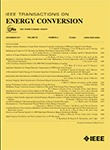
This paper proposes a new fast charging strategy for lithium-ion (Li-ion) batteries. The approach relies on an experimentally validated high-fidelity model describing battery electrochemical and thermal dynamics that determine the fast charging capability. Such a high-dimensional nonlinear dynamic model can be intractable to compute in real-time if it is fused with the extended Kalman filter or the unscented Kalman filter that is commonly used in the community of battery management. To significantly save computational efforts and achieve rapid convergence, the ensemble transform Kalman filter (ETKF) is selected and tailored to estimate the nonuniform Li-ion battery states. Then, a health- and safety-aware charging protocol is proposed based on successively applied proportional-integral (PI) control actions. The controller regulates charging rates using online battery state information and the imposed constraints, in which each PI control action automatically comes into play when its corresponding constraint is triggered. The proposed physical constraint-triggered PI charging control strategy with the ETKF is evaluated and compared with several prevalent alternatives. It shows that the derived controller can achieve close to the optimal solution in terms of charging time and trajectory, as determined by a nonlinear model predictive controller, but at a drastically reduced computational cost.
Published in IEEE Transactions on Power Electronics, March 25, 2021 [FullText]
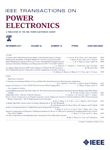
The installation of current sensors on lithium-ion batteries (LIBs) can be challenging due to practical constraints in specific applications like portable electronics and smart batteries. Motivated by this, our letter proposes a method for online load current and state-of-charge (SOC) coestimation, which mitigates the need of installing the current sensor for LIB management. The essence is to transform the state observation into a constrained optimization problem, which is solved numerically in a moving horizon framework to allow the online coestimation of SOC and input current. Experimental results suggest that the proposed method can coestimate the load current and SOC of LIB precisely even if the current sensor is absent. The encouraging results are insightful for reducing the structural complexity and cost of future LIB utilization.
Published in IEEE Transactions on Industrial Electronics, April 7, 2021 [FullText]
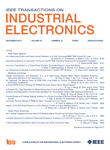
Fast charging is an enabling technique for the large-scale penetration of electric vehicles. This article proposes a knowledge-based, multiphysics-constrained fast charging strategy for lithium-ion battery (LIB), with a consciousness of the thermal safety and degradation. A universal algorithmic framework combining model-based state observer and a deep reinforcement learning (DRL)-based optimizer is proposed, for the first time, to provide a LIB fast charging solution. Within the DRL framework, a multiobjective optimization problem is formulated by penalizing the over-temperature and degradation. An improved environmental perceptive deep deterministic policy gradient (DDPG) algorithm with priority experience replay is exploited to tradeoff smartly the charging rapidity and the compliance of physical constraints. The proposed DDPG-DRL strategy is compared experimentally with the rule-based strategies and the state-of-the-art model predictive controller to validate its superiority in terms of charging rapidity, enforcement of LIB thermal safety and life extension, as well as the computational tractability.
Published in IEEE Transactions on Industrial Electronics, July 14, 2021 [FullText]
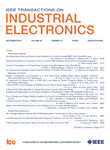
In this article, a computationally efficient state estimation method for lithium-ion (Li-ion) batteries is proposed based on a degradation-conscious high-fidelity electrochemical–thermal model for advanced battery management systems. The computational burden caused by the high-dimensional nonlinear nature of the battery model is effectively eased by adopting an ensemble-based state estimator using the singular evolutive interpolated Kalman filter (SEIKF). Unlike the existing schemes, it shows that the proposed algorithm intrinsically ensures mass conservation without imposing additional constraints, leading to a battery state estimator simple to tune and fast to converge. The model uncertainty caused by battery degradation and the measurement errors are properly addressed by the proposed scheme as it adaptively adjusts the error covariance matrices of the SEIKF. The performance of the proposed adaptive ensemble-based Li-ion battery state estimator is examined by comparing it with some well-established nonlinear estimation techniques that have been used previously for battery electrochemical state estimation, and the results show that excellent performance can be provided in terms of accuracy, computational speed, and robustness.
Published in IEEE Industrial Electronics Magazine, August 17, 2021 [FullText]
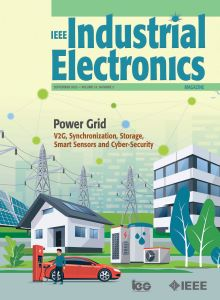
To unlock the promise of electrified transportation and smart grid, emerging advanced battery management systems (BMSs) shall play an important role in health-aware monitoring, diagnosis, and control of widely used lithium-ion (Li-ion) batteries. Sophisticated physics-based battery models incorporated in the advanced BMS can offer valuable battery internal information to achieve improved operational safety, reliability and efficiency, and to extend the lifetime of the batteries. However, developed from the fundamental electrochemical and thermodynamic principles, the rigorous physics-based models are saddled with exceedingly high cognitive and computational complexity for practical applications. This article reviews prevailing order reduction techniques of physics-based Li-ion battery models to facilitate the development of next-generation BMSs. We analyze and comparatively characterize these techniques, mainly from perspectives of model fidelity, computational efficiency, and the scope of applications. By representing many effective and flexible reduced-order models as equivalent circuits, designers and practitioners, who do not have electrochemical expertise but with knowledge of circuit theory, can readily gain insights into multi-physical dynamics as well as their coupling effects inside the batteries. In addition, recommendations are made on how to select appropriate physics-based models for various model-based applications in battery management. Finally, the prospect of physical model-enabled BMSs is discussed, including the potential challenges and future research directions.
Published in IEEE Transactions on Transportation Electrification, September 20, 2021 [FullText]
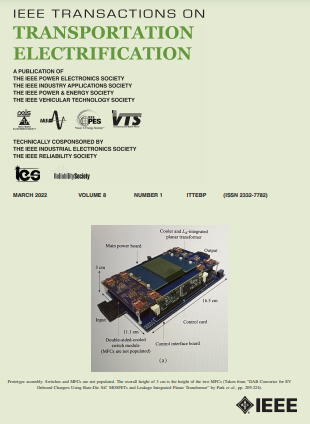
At low operating temperatures, the power capability and charging/discharging capacity of lithium-ion (Li-ion) batteries can decay rapidly. Therefore, it is essential to preheat the Li-ion batteries in advance of the normal operations of a battery electric vehicle. High-frequency ac preheating methods are advantageous to achieve a miniaturized and lightweight design. In this article, a self-heating circuit topology is used for studying the characteristics of Li-ion batteries at low temperatures and under high-frequency ac excitation. The thermal behaviors of Li-ion batteries under high-frequency ac excitations are comprehensively analyzed with an improved heat generation model. Experimental results exhibit that heat generation due to electrochemical reactions has a significant influence on self-heating rates under the high-frequency ac excitation, and the heating rate is positively correlated with the current frequency and root-mean-square (rms) value. Specifically, when the current frequency is 90 kHz and the rms value is 3.51 A or 1.17 C, validated by experiment and numerical simulation, a 2.9-Ah 18650 Li-ion cell can be heated up from −20 °C to 5 °C in 7.33 min with an average electrochemical heat generation of 2.962 W.
Published in Energy, September 24, 2021 [FullText]
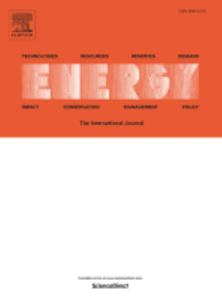
In order to increase the energy conversion efficiency of thermoelectric generators for automobile systems where the heat sources are commonly cylindrical, a novel concentric annular thermoelectric generator (CATEG) consisting of annular thermocouples and a concentric annular heat exchanger is proposed. A numerical model of the CATEG is first established using a finite-element method, based on which the thermoelectric performances of the proposed CATEG and the conventional annular thermoelectric generator (ATEG) with a cylindrical heat exchanger are compared. The relationship between the size of the heat exchanger, heat transfer characteristics, and heat flow resistances are comprehensively studied. Furthermore, to balance the relationship between heat transmission and fluid flow resistances, and to extract the maximum net power, the optimal design of the concentric annular exchanger is obtained and analyzed. Simulation results show that the optimized ratio of the inner and outer diameters of the heat exchanger is 0.94, and the new ATEG with the proposed concentric annular heat exchanger can significantly increase the total heat transfer coefficient as well as the pressure drop, leading to a maximum net power of 65% higher than the conventional ATEG.
Published in Energy, October 11, 2021 [FullText]
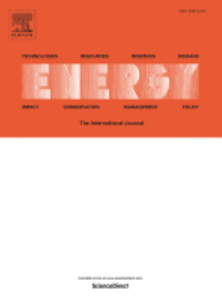
The annular thermoelectric generator (ATEG) has received growing research interest due to its improved energy conversion efficiency compared to conventional flat-plate thermoelectric generators (FTEG). In this study, considering the influence of ceramic substrate and copper contact layer, a numerical model of the annular thermoelectric module (ATEM) was established for the studies of the influence of geometrical parameters on output performance under three typical application scenarios with different boundary conditions. It is found that when the heat flow on hot side is constant, the shape factors of the optimal performance are slightly different either if the convection coefficient or the temperature is considered constant on cold side. In both cases, the output power and the conversion efficiency decrease with the increase of the thickness of the thermocouple, and increase with the increase of the angle, length, and number of the thermocouples. When the temperatures are considered constant on both sides of the thermocouples, a conflicting relationship between the optimal output power and the efficiency exists. In this case, to obtain the best ATEG performance, multi-optimization problem is formulated and solved by the non-dominant sorting genetic algorithm with elite strategy method (NSGA-II).
Published in Applied Energy, October 11, 2021 [FullText]
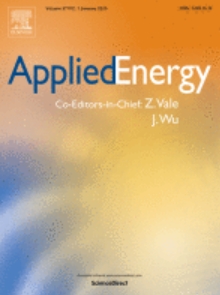
Practical applications of thermoelectric generators are impeded by their low thermoelectric conversion efficiency, and improving the efficiency is vital for the advancements of thermoelectric technology. In this paper, a novel method is proposed for the performance analysis and improvement of the annular thermoelectric generators with variable-angle PN legs (VATEGs). The influence of the PN leg angle on the output performance of the VATEG is investigated by introducing an angle function. Given the volume of the PN legs, the relationship of output performance between the VATEG and traditional constant-angle ATEG (CATEG) is established under different boundary conditions based on a proposed generic model of VATEG. The results are verified numerically using the finite element method. Using the model, it is shown that the output performance of the VATEG is significantly affected by the shape of the PN leg. Finally, the thermal stress on the PN leg is next investigated using a high-fidelity 3D model of the variable-angle PN legs implemented in COMSOL, and it is found that the shape difference has a considerable influence on the thermal stability of VATEG. Under the condition of constant heat flux on the hot side and constant temperature on the cold side of the thermoelectric modules, it shows that when the radius factor is 2, the output performance can be improved by 35% with the designed VATEG, at the expense of 30% higher maximum thermal stress on the PN legs.
Published in IEEE Transactions on Transportation Electrification, November 19, 2021 [FullText]
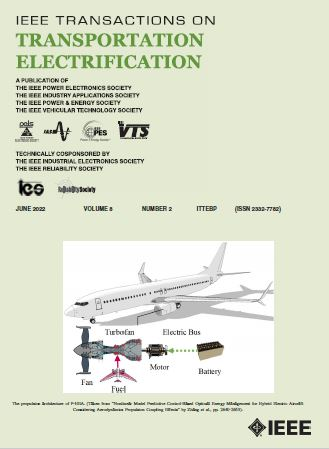
This article proposes an adaptive state-of-health (SOH) estimation method for lithium-ion (Li-ion) batteries using machine learning. Practical problems with feature extraction, cell inconsistency, and online implementability are specifically solved using a proposed individualized estimation scheme blending offline model migration with online ensemble learning. First, based on the data of pseudo-open-circuit voltage measured over the battery lifespan, a systematic comparison of different incremental capacity features is conducted to identify a suitable SOH indicator. Next, a pool of candidate models, composed of slope-bias correction (SBC) and radial basis function neural networks (RBFNNs), are trained offline. For online operation, the prediction errors due to cell inconsistency in the target new cell are then mitigated by a proposed modified random forest regression (mRFR)-based ensemble learning process with high adaptability. The results show that compared to prevailing methods, the proposed SBC-RBFNN-mRFR-based scheme can achieve considerably improved SOH estimation accuracy (15%) while only a small amount of early-age data and online measurements are needed for practical operation. Furthermore, the applicability of the proposed SBC-RBFNN-mRFR algorithms to real-world operation is validated using measured data from electric vehicles, and it is shown that a 38% improvement in estimation accuracy can be achieved.
Published in IEEE Transactions on Transportation Electrification, November 25, 2021 [FullText]
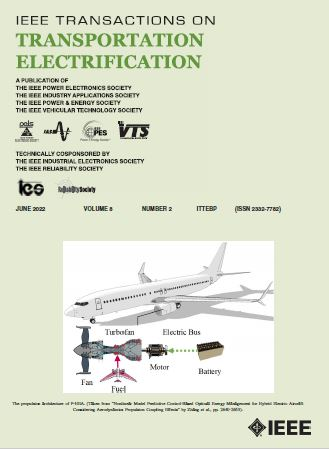
Considered as one of the ultimate energy storage technologies for electrified transportation, the emerging all-solid-state batteries (ASSBs) have attracted immense attention due to their superior thermal stability, increased power and energy densities, and prolonged cycle life. To achieve the expected high performance, practical applications of ASSBs require accurate and computationally efficient models for the design and implementation of many onboard management algorithms so that the ASSB safety, health, and cycling performance can be optimized under a wide range of operating conditions. A control-oriented modeling framework is thus established in this work by systematically simplifying a rigorous partial differential equation (PDE)-based model of the ASSBs developed from underlying electrochemical principles. Specifically, partial fraction expansion and moment matching (PFE-MM) are used to obtain ordinary differential equation-based reduced-order models (ROMs). By expressing the models in a canonical circuit form, excellent properties for control design, such as structural simplicity and full observability, are revealed. Compared to the original PDE model, the developed ROMs have demonstrated high fidelity at significantly improved computational efficiency. Extensive comparisons have also been conducted to verify its superiority to the prevailing models due to the consideration of concentration-dependent diffusion and migration. Such ROMs can thus be used for advanced control design in future intelligent management systems of ASSBs.
Published in Applied Energy, December 1, 2021 [FullText]
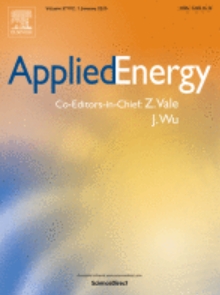
Accurate current measurement is indispensable for the management of lithium-ion battery (LIB), especially for the state-of-charge (SOC) estimation. However, accurate current sensing is challenging in electric vehicles (EVs) due to the electromagnetic interference. Moreover, the currents across the parallel branches of battery pack are even unmeasurable due to the absence of current sensor. Motivated by this, this paper proposes a hierarchical soft measurement framework for the load current and SOC addressing different degrees of current sensor uncertainty. Rooted from a common least squares (LS)-based state optimization problem, a total least square (TLS)-based modification is proposed and solved to compensate for the measurement disturbances, and in accordance to estimate the SOC more accurately. One step further, an input-free optimization method is proposed to co-estimate the SOC and load current without using the current measurements. Simulation and experimental results suggest that the proposed hierarchical framework can realize high-fidelity co-estimation of the SOC and load current, especially in the adverse scenarios of both strong noise corruption and current sensor malfunction/missing. The encouraging results open new paradigms for both the high-robustness current-free SOC estimation and the hardware-free soft current measurement of LIB.
Published in IEEE Transactions on Power Electronics, January 21, 2022 [FullText]
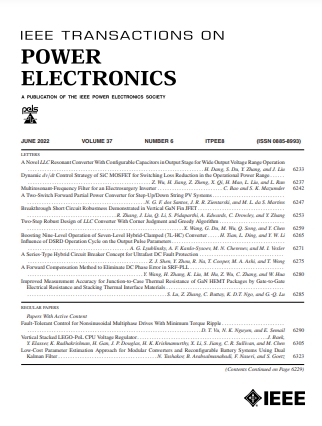
State of health (SOH) is critical to the management of lithium-ion batteries (LIBs) due to its deep insight into health diagnostic and protection. However, the lack of complete charging data is common in practice, which poses a challenge for the charging-based SOH estimators. This article proposes a multistage SOH estimation method with a broad scope of applications, including the unfavorable but practical scenarios of heavily partial charging. In particular, different sets of health indicators (HIs), covering both the morphological incremental capacity features and the voltage entropy information, are extracted from the partial constant-current charging data with different initial charging voltages to characterize the aging status. Following this endeavor, artificial neural network based HI fusion is proposed to estimate the SOH of LIB precisely in real time. The proposed method is evaluated with long-term aging experiments performed on different types of LIBs. Results validate several superior merits of the proposed method, including high estimation accuracy, high tolerance to partial charging, strong robustness to cell inconsistency, and wide generality to different battery types.
Published in IEEE Journal of Emerging and Selected Topics in Power Electronics, February 17, 2022 [FullText]
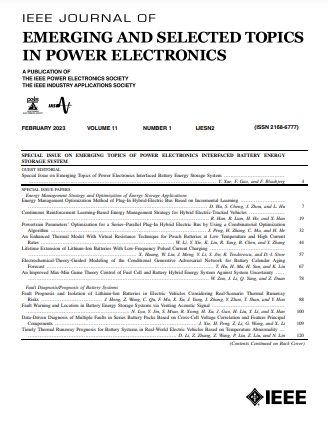
The peak power of a vanadium redox flow battery (VRB) reflects its capability to continuously absorb or release energy. Accurate estimation of peak power is essential for the safe, reliable, and efficient operation of VRB systems, but also challenging as it is limited by various factors, such as currents, flow rates, temperature, and state of charge. This article proposes a new online model-based peak power estimation scheme for VRBs. First, the model parameters and system states are accurately estimated using the recursive least squares with forgetting and the unscented Kalman filter, respectively. Next, based on a linear time-varying VRB model and the estimated states, the peak power estimation is formulated into an optimal control problem, and the problem is solved using the receding horizon control (RHC). The influence of the predictive horizon on the estimated peak power is discussed. Finally, the effectiveness of the proposed RHC-based peak power estimation scheme is experimentally verified on a 5-kW/3-kWh VRB platform.
Published in Journal of the Electrochemical Society, March 4, 2022 [FullText]
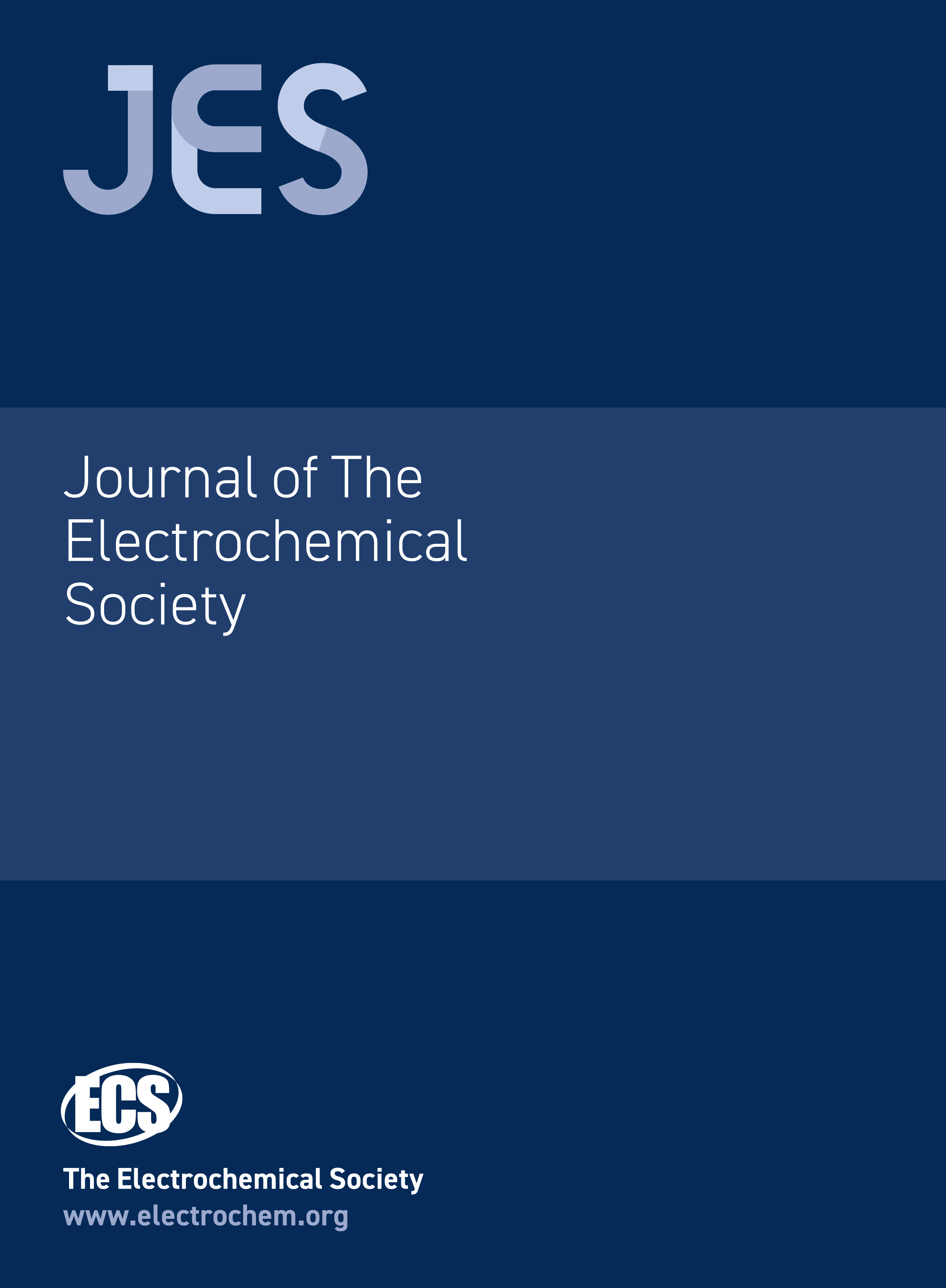
The output characteristics of the Proton-Exchange Membrane Fuel Cells (PEMFCs) are affected by multiple factors, but quantitatively describing the relationships is challenging. In this paper, a semi-empirical dynamic model of PEMFC is established firstly. The influence of a single factor on the output characteristics of PEMFC is analyzed longitudinally. Then, a derivative significance weight analysis based on support vector regression (SVR-DSWA) algorithm is proposed to analyze the influence weights of multi-factors on the output characteristics, and the optimal parameters combinations in different current density regions are obtained by maximizing the output voltage values based on formulated SVR model. The Root-Mean-Square Error (RMSE) of output voltage prediction results based on the SVR algorithm is less than 0.0458, and the accuracy of weight analysis results by using the SVR-DSWA algorithm and the optimal parameters combinations analysis method are verified by 4-factor 3-level orthogonal experiments in low, medium, and high current density regions. The SVR-DSWA algorithm and optimal parameters combinations analysis method can replace the orthogonal experiment to analyze the influence weights and optimal combinations of input factors on the output characteristics within the full current density range rapidly, and has much higher efficiency than the orthogonal experiment. The analysis results can provide theoretical support for improving fuel cell performance and formulating a control strategy.
Published in Energy Reports, March 27, 2022 [FullText]
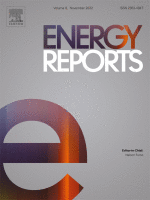
The inevitable non-uniform temperature distribution across a large number of thermoelectric modules can cause reduced output power of the automotive exhaust thermoelectric generator (AETEG). In order to achieve accurate tracking of maximum power point for an AETEG, a distributed thermoelectric energy recovery system is proposed consisting of several parallel thermoelectric generators and a lithium-ion battery pack. And then, a two-level energy harvesting strategy is developed to efficiently recover exhaust energy under dynamic driving cycles. The simulated results based on an experimentally validated system model under the modified Highway Fuel Economy Test (HWFET) for a commercial heavy-duty vehicle demonstrate that the proposed strategy enables the system to run at the efficient working point of DC/DC converters. It shows that the charging energy can be increased by 174013 J and the efficiency of system-control level can be raised by 2.4% compared to the conventional feedback control under the modified HWFET driving cycle, when the initial State of Charge (SOC) of the battery pack is 10%. Meanwhile, the proposed strategy can avoid the over-charging events for the battery pack since it can be effectively controlled along its pre-defined optimal working trajectory, which is verified by the campus road test.
Published in International Journal of Energy Research, May 22, 2022 [FullText]

The existing impedance estimation methods for proton exchange membrane fuel cell (PEMFC) based on single equivalent circuit model (ECM) cannot accurately measure electrochemical impedance spectroscopy (EIS) at all times in the future or in the whole frequency range, which affects the accuracy of state-of-health (SOH) estimation with EIS as aging index. Therefore, a novel health assessment approach based on multi-model probability fusion is proposed for improving the accuracy and reliability of SOH estimation. Five typical ECMs are selected to describe PEMFC, and chaotic particle swarm optimization algorithm with dynamic inertia weight (DIW-CPSO) is used for identifying the model parameters. The parameters related to aging are extracted for predicting the SOH, and Bayesian theorem-based multi-model probability approach is adopted to calculate the optimal weights of synthesizing the SOHs estimated by the five ECMs. This approach is applied to real EIS data sets of Stack FC at current 20A, 45A and 70A. The results show that the EIS estimation results of the proposed approach have better performance in the sense of root mean square error and Euclidean error. The accuracies of SOH evaluation are 46.38%, 28.69% and 10.94% higher than the single ECM respectively, and have higher accuracy compared with previous studies.
Published in IEEE Transactions on Sustainable Energy, June 10, 2022 [FullText]
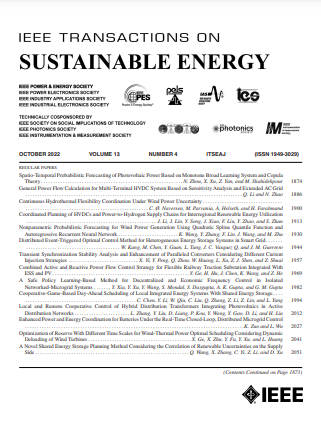
The low energy conversion efficiency of the vanadium redox flow battery (VRB) system poses a challenge to its practical applications in grid systems. The low efficiency is mainly due to the considerable overpotentials and parasitic losses in the VRB cells when supplying highly dynamic charging and discharging power for grid regulation. Apart from material and structural advancements, improvements in operating strategies are equally essential for achieving the expected high-performance VRB system, although an optimized solution has not been fully exploited in the existing studies. In this paper, a two-stage control strategy is thus developed based on a proposed and experimental validated multi-physics multi-time-scale electro-thermo-hydraulic VRB model. Specifically, in the first stage, the optimal flow rate of the VRB is obtained based on online optimization to reduce parasitic loss and enhance instantaneous system efficiency, and the result serves as the set point of a feedback flow rate controller. In the second stage, dual time scales are specifically considered. And the current and flow rate controllers are designed to meet the highly varying power demands for grid-connected applications. The effectiveness of the proposed control strategy is verified under a scenario to smooth wind power generation. Comparative studies show that compared to the prevailing approaches, higher efficiency can be achieved in tracking the theoretical optimal power profiles for online battery control.
Published in Renewable Energy, August 7, 2022 [FullText]
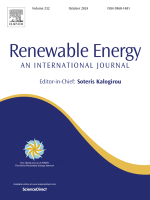
Highly variable automobile operating conditions and the ever-fluctuating exhaust parameters pose fundamental challenges to optimizing the design of automobile annular thermoelectric generators (ATEGs). This paper establishes an advanced non-isothermal mathematical model of ATEGs using the finite element method for solving this problem. First, the effects of different vehicle operating conditions on the optimal thermoelectric semiconductor volume are investigated. Based on the results, the optimal range for selecting the thermocouple volume is determined. Aiming to maintain a high net power of ATEG under variable operating conditions, two new schemes are proposed to optimize the system configuration, including 1) a weighted power deviation method and 2) a multi-objective intelligent optimization algorithm. Then, a new method for assessing the power generation cost is proposed for the ATEG. Combined with the characteristics of vehicle exhaust fluctuation in the New European Driving Cycle, the economics of the above two schemes are calculated and compared, and the optimal design is obtained. The results show that the optimal ATEG system configuration is: the PN couple volume in a single ring is 5.0625 × 10−6 m3, the total PN couple volume is 2.835 × 10−4 m3, and the net power and the efficiency can reach 20.85 W and 3.9%, respectively. The proposed model and method contribute to optimize the structural configuration of the on-board ATEGs, and can be further extended for other application scenarios of the thermoelectric generator system.
Published in Energy Conversion and Management, September 26, 2022 [FullText]
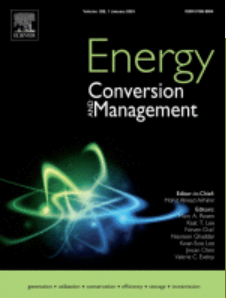
The adaptation of annular thermoelectric generator (ATEG) to cylindrical heat sources exhibits a better performance compared to widely studied flat plate type thermoelectric generator (FTEG). To enhance heat transfer and improve the overall performance, a novel structure of the heat exchanger of the twisted-tape annular thermoelectric generator (TT-ATEG) is proposed in this paper. A three-dimensional finite element model of TT-ATEG is established for the first time. The net power gain coefficient and the efficiency gain coefficient are defined to quantify the performance of TT-ATEG, and the gain effects of the length, twist ratio and radius of the twisted tape are analyzed respectively. To maximize the comprehensive performance of TT-ATEG, the optimal weighting factor of net power and efficiency are determined, and the full-parameter optimization of the twisted tape is completed. The results reveal that the optimal performance of TT-ATEG is obtained if the weight ratio of net power and conversion efficiency is 1:4. In our case study, dimensionless factors radius ratio Rr, length ratio Lr and twist ratio of the twisted tape are 0.714, 0.479 and 136.84 respectively. Compared with the ATEG without twisted tape, the net power and efficiency are improved by 10.41% and 22.51%, respectively. The results demonstrate that the novel design of TT-ATEG could accelerate the heat transfer effectively and enhance the overall performance.
Published in Applied Thermal Engineering, December 5, 2022 [FullText]
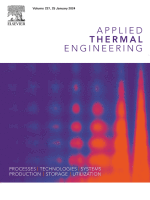
The conventional methods to improve the performance of annular thermoelectric generators (ATEGs) heavily rely on optimizing the thermal design of individual annular thermoelectric couples (ATECs). However, since a practical ATEG consists of many ATECs, the optimal structure of the ATEG can differ from the ATEC-based design. On the other hand, optimization by simply considering all ATECs can lead to a heavy computation burden. This work first proposes a high-fidelity, fluid-thermal-electric multiphysical ATEG model, solved by a computationally-efficient dual-finite-element method to cope with the challenge. This model explores the effects of ATEC microstructure and heat exchanger structure on ATEG performance under various operating conditions. Comparative multi-objective optimization studies were performed at three levels, i.e., for a single ATEC, a single ring of ATEG, and the entire ATEG. The results reveal that the optimized structural parameters of ATECs have some new features when considering the entire ATEG as the optimization objective. The optimal height, angle, and thickness of ATECs are 12 mm, 2.35°, and 10 mm, respectively. The corresponding net power, efficiency, and power density of ATEG are 321.6 W, 6.58%, and 634.15 W/m3, respectively. Compared to the traditional design method based on a single ATEC and a single ring, the net power of the ATEG designed with the proposed method can be enhanced by 168% and 197%, respectively, at the expense of only a 20% reduction in the power density.
Published in International Journal of Hydrogen Energy, December 7, 2022 [FullText]
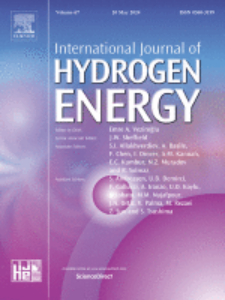
Hydrogen production from wind power has become one of the most important technologies for the large-scale comprehensive development and utilization of wind power, but the randomness of wind power has a large negative impact on the stability and cost of such wind-hydrogen hybrid energy systems. In this work, we initially analyze the relationship between electrolyzer efficiency and degradation with a three-dimensional multi-physics field model of PEMWE single-cell. Optimization of a power allocation strategy for wind-hydrogen system with a multi-stack PEM water electrolyzer (PEMWE) is proposed by considering degradation conditions. The multi-stack PEMWE power allocation strategy consists of the control module and execution module. In the control module, the degradation of PEMWE is quantified using the voltage degradation rate under different operating conditions. By setting the turning power point and external power supply and calculating the power allocation order online to reduce the degradation of PEMWE. In the execution module, the extended duty cycle interleaved buck converter (EDCIBC) based on fuzzy PID control is used to power each PEMWE single-stack. Case studies are carried out via computer simulation based on the configuration and experimental data for a specific wind farm located in Cixi, Zhejiang, China. Our results show that the energy efficiency of the wind-hydrogen system is 61.65% in a one-year operation, the voltage degradation of the PEMWE single-stack is 7.5 V, and the maximum efficiency is 6.29% lower than that when it is not aged. The EDCIBC output current ripple is as low as 0.053%, which rapidly and accurately follows the generated power allocation signal.
Published in Energy Storage Materials, January 7, 2023 [FullText]
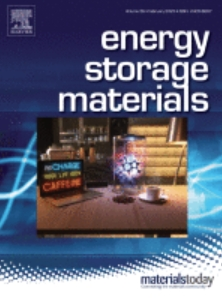
Fast charging of the lithium-ion battery (LIB) is an enabling technology for the popularity of electric vehicles. However, high-rate charging regardless of the physical limits can induce irreversible degradation or even hazardous safety issues to the LIB system. Motivated by this, this paper proposes a machine learning-based fast charging strategy with multi-physical awareness within a battery-to-cloud framework. In particular, a reduced-order electrochemical-thermal model is built in the cloud to perceive the microscopic states of LIB, leveraging which the soft actor-critic (SAC) deep reinforcement learning (DRL) algorithm is exploited for the first time to train a fast charging strategy. Hardware-in-Loop tests and experiments with practical LIBs are carried out for validation. Results suggest that the battery-to-cloud architecture can mitigate the risk of a heavy computing burden in the real-time controller. The proposed strategy can effectively mitigate the unfavorable over-temperature and lithium deposition, which benefits the safety and longevity during fast charging. Given a similar charging speed, the proposed machine learning approach extends the LIB cycle life by about 75% compared to the commonly-used empirical protocol. Meanwhile, the proposed strategy is proven superior to the state-of-the-art rule-based and the model-based strategies in terms of charging rapidity, charging safety and computational complexity. Moreover, the trained low-complexity strategy is highly adaptive to the ambient temperature and initial charging state, which promises robust performance in practical applications.
Published in eTransportation, January 31, 2023 [FullText]

Machine learning is very important in predicting the degraded performance of fuel cell systems for advanced diagnosis and control. Unfortunately, existing machine-learning-based schemes are usually designed with point estimation, making it difficult to quantify the uncertainty of the prediction result. In this paper, we propose a Bayesian-Gated Recurrent Unit model (B-GRU) that combines the Bayesian Theory and GRU to predict the phenomenon of fuel cell voltage decay. Fuel cell data are preprocessed by the random forest, and the key feature data are then imported into the B-GRU. Variational inference and adaptive moment estimation is used to obtain the optimal parameters in the B-GRU. Probability density distributions are calculated by replacing the parameters in GRU with random variables to quantify the uncertainty in the model. In addition to providing point estimates, the B-GRU also gives interval estimates for uncertainty quantification. With small training data, the point estimation result of B-GRU is more accurate than traditional neural networks. Furthermore, compared to the Bayesian neural networks, the proposed B-GRU also exhibits superior performance both in point and interval estimation results based on the IEEE PHM 2014 DATA Challenge dataset. With its excellent ability for noise immunity and uncertainty quantification, the proposed prediction method can provide more useful decision-making recommendations for hydrogen energy devices.
Published in IEEE Transactions on Industrial Informatics, February 2, 2023 [FullText]
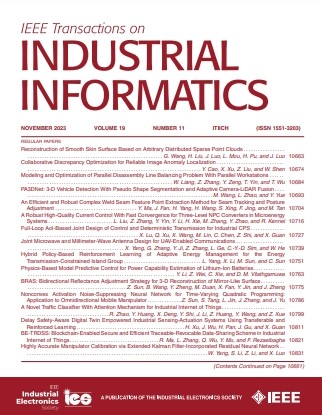
The power capability of a lithium-ion battery signifies its capacity to continuously supply or absorb energy within a given time period. For an electrified vehicle, knowing this information is critical to determining control strategies such as acceleration, power split, and regenerative braking. Unfortunately, such an indicator cannot be directly measured and is usually challenging to be inferred for today’s high-energy type of batteries with thicker electrodes. In this work, we propose a novel physics-based battery power capability estimation method to prevent the battery from moving into harmful situations during its operation for its health and safety. The method incorporates a high-fidelity electrochemical-thermal battery model, with which not only the external limitations on current, voltage, and power but also the internal constraints on lithium plating and thermal runaway, can be readily taken into account. The online estimation of maximum power is accomplished by formulating and solving a constrained nonlinear optimization problem. Due to the relatively high system order, high model nonlinearity, and long prediction horizon, a scheme based on multistep nonlinear model predictive control is found to be computationally affordable and accurate.
Published in Journal of Power Sources, March 1, 2023 [FullText]
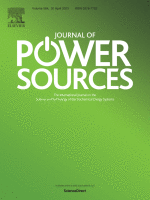
The porous electrode of vanadium redox flow batteries (VRBs) is subject to deformation due to mechanical stress during stack assembling. The forces compress the electrode fiber into the flow channel and thus alter the electrode porosity ratio. Due to the complex mechanisms, the effects of resulting electrode morphological changes on VRB performance were usually ignored in existing studies. This paper proposes a three-dimensional VRB model considering the uneven electrode deformation to investigate the cell performance under different electrode compression ratios with three flow-field designs. Compression ratio (CR) and the intrusive part of the electrode are obtained under various mechanical stress by adjusting gasket thickness in the experiment. The proposed electrochemical model is established based on the comprehensive description of conservation laws and analyzed using the COMSOL platform. Three indices, namely the concentration overpotential, pressure drop, and distribution uniformity, are selected for the analysis under the three flow field designs and different CRs. The numerical study reveal that the pressure drop and the concentration overpotential are sensitive to the CR but less affected by the concentration uniformity. The minimum overpotential can be reached when the CR is around 40%–50%, depending on flow field designs, while a higher CR can cause a drastically increased pressure drop. It is also found that the interdigitated flow field with a CR of 45% is considered optimal. The insights from the proposed method demonstrate the significance of considering the effects of electrode deformation in the stack design under various flow fields.
Published in IEEE Transactions on Transportation Electrification, April 11, 2023 [FullText]
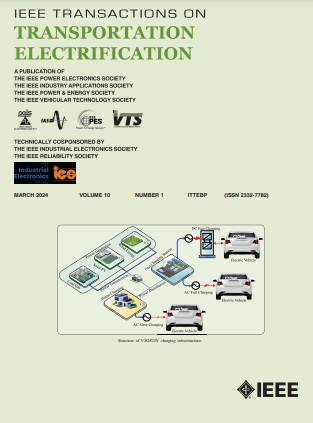
Early prediction of aging trajectories of lithium-ion (Li-ion) batteries is critical for cycle life testing, quality control, and battery health management. Although data-driven machine learning (ML) approaches are well suited for this task, unfortunately, relying solely on data is exceedingly time-consuming and resource-intensive, even in accelerated aging with complex aging mechanisms. This challenge is rooted in the highly complex and time-varying degradation mechanisms of Li-ion battery cells. We propose a novel method based on physics-guided machine learning (PGML) to overcome this issue. First, electrode-level physical information is incorporated into the model training process to predict the aging trajectory’s knee point (KP). The relationship between the identified KP and the accelerated aging behavior is then explored, and an aging trajectory prediction algorithm is developed. The prior knowledge of aging mechanisms enables a transfer of valuable physical insights to yield accurate KP predictions with small data and weak correlation feature relationship. Based on a Li[NiCoMn]O 2 cell dataset, we demonstrate that only 14 cells are needed to train a PGML model for achieving a lifetime prediction error of 2.02% using the data of the first 50 cycles. In contrast, at least 100 cells are needed to reach this level of accuracy without the physical insights.
Published in Energy, April 20, 2023 [FullText]
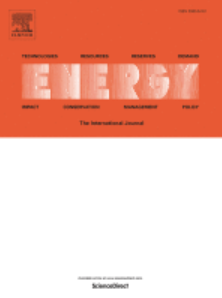
This paper proposes a multi-peak maximum power point tracking (MPPT) method based on the Global Flying Squirrel Search-Particle Swarm Optimization (GFSS-PSO) for centralized thermoelectric generator (TEG) systems operating under uneven temperature distribution conditions. Conventionally, metaheuristic-based MPPT methods mainly focused on indicators such as tracking speed, oscillation amplitude, and system efficiency. However, the real-time global search ability of conventional metaheuristic-based MPPT methods designed for photovoltaic systems may not be suitable for the gradual temperature change in the thermoelectric scene. A strong global search capability also can add to the computational burden and increase the power loss in the search process. To solve these problems, the GFSS-PSO algorithm introduces improved position updating method and multi-threshold restart mechanisms to reduce energy loss and improve the dynamic performance under temperature change. The proposed method has been compared with the perturb and observe method and several state-of-the-art metaheuristic-based MPPT algorithms. Simulation results confirm that GFSS-PSO demonstrates exceptional performance and generates higher energy levels compared to perturb and observe, grey wolf optimizer, and flying squirrel search optimization methods during the search phase under dynamic temperature conditions. The improvements achieved by GFSS-PSO are remarkable, with energy levels increasing by 118.3%, 105%, and 102.2% respectively. Finally, experiments are conducted to verify the effectiveness of the proposed algorithm in a real-time digital system.
Published in IEEE Transactions on Transportation Electrification, May 9, 2023 [FullText]
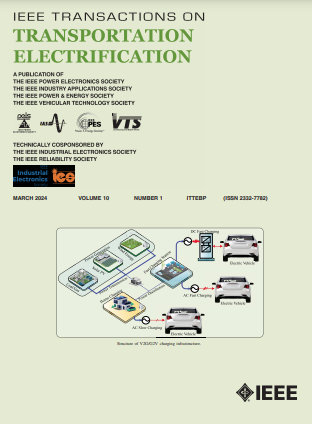
Accurate state of charge (SoC) estimation of traction batteries plays a crucial role in energy and safety management for electric vehicles (EVs). Existing studies focus primarily on cell battery SoC estimation. However, numerical instability and divergence problems might occur for a large-size lithium-ion battery pack consisting of many cells. This article proposes a high-performance online model parameters identification and SoC estimation method based on an adaptive square root unscented Kalman filter (ASRUKF) and an improved forgetting factor recursive least squares (IFFRLS) for vehicle-level traction battery packs. The model parameters are identified online through the IFFRLS, where the conventional method might encounter numerical stability problems. By updating the square root of the covariance matrix, the divergence problem in the traditional unscented Kalman filter (KF) is solved in the ASRUKF algorithm, where the positive semidefiniteness of the covariance matrix is guaranteed. Combined with the adaptive noise covariance matched filtering algorithm and real-time compensation of system error, the proposed method solves the problem of ever-degrading estimation accuracy in the presence of time-varying noise with unknown statistical characteristics. Using a 66.2-kWh vehicle battery pack, we experimentally verified that the proposed algorithm could achieve high estimation accuracy with guaranteed numerical stability. The maximum error of SoC estimation can be bounded by 1%, and the root-mean-square error is as low as 0.47% under real-world vehicle operating conditions.
Published in Renewable Energy, June 12, 2023 [FullText]
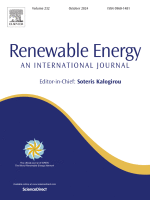
Proton exchange membrane fuel cells (PEMFCs) are essential modern sustainable energy generation devices. Since such an electrochemical system has a limited lifetime, accurately estimating its performance degradation is critical for practical applications. When a large amount of measurement data is available, many nonlinear forecasting methods can be used to predict the performance degradation of a PEMFC system, and the prediction accuracy can be improved by optimizing the structure and parameters of the algorithm. However, the voltage recovery phenomenon would pose a challenge to the classical data-driven methods. In this work, we propose a novel hybrid data-driven PEMFC performance prediction framework by exploring the extensive degradation information buried in the voltage decay data. With complete ensemble empirical mode decomposition with adaptive noise (CEEMDAN), the raw voltage data are first decomposed into sequences of multiple time scales. Then, the linear and nonlinear components in the decomposed sequences are predicted by autoregressive integrated moving average (ARIMA) and the attention-based gated recurrent unit (GRU), respectively. Comparative studies show that the proposed method can improve the prediction performance by 42.6%–84.2% on FC1 and 35.0%–90.6% on FC2, compared to state-of-the-art algorithms on the basis of an open-source dataset of PEMFCs.
Published in Green Energy and Intelligent Transportation, June 24, 2023 [FullText]
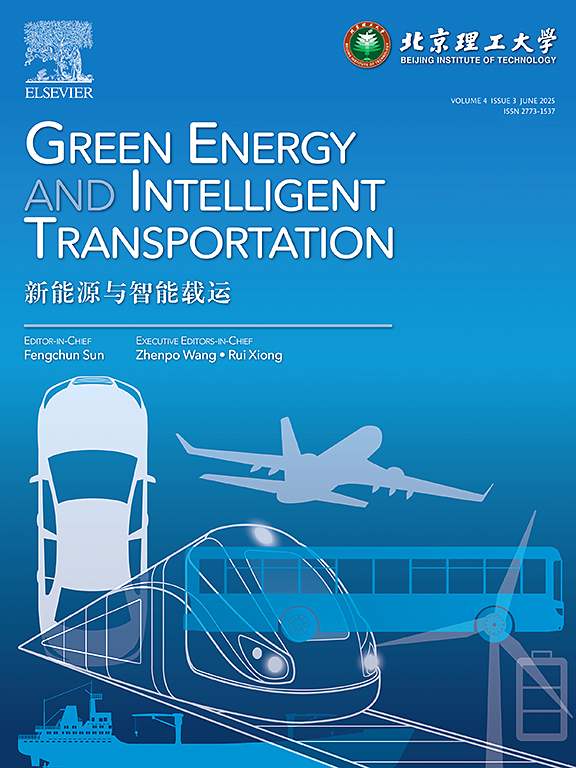
The water content of proton exchange membrane fuel cells (PEMFCs) affects the transport of reactants and the conductivity of the membrane. Effective water management measures can improve the performance and extend the lifespan of the fuel cell. The water management state of the stack is influenced by various external operating conditions, and optimizing the combination of these conditions can improve the water management state within the stack. Considering that the stack’s internal resistance can reflect its water management state, this study first establishes an internal resistance-operating condition model that considers the coupling effect of temperature and humidity to determine the variation trend of total resistance and stack humidity with single-factor operating conditions. Subsequently, the water management state optimization method based on the ANN-HGPSO algorithm is proposed, which not only quantitatively evaluates the influence weights of different operating conditions on the stack’s internal resistance but also efficiently and accurately obtains the optimal combination of five operating conditions: working temperature, anode gas pressure, cathode gas pressure, anode gas humidity, and cathode gas humidity to achieve the optimal water management state in the stack, within the entire range of current densities. Finally, the response surface experimental results of the stack also validate the effectiveness and accuracy of the ANN-HGPSO algorithm. The method mentioned in this article can provide effective strategies for efficient water management and output performance optimization control of PEMFC stacks.
Published in IEEE Transactions on Control Systems Technology, July 18, 2023 [FullText]
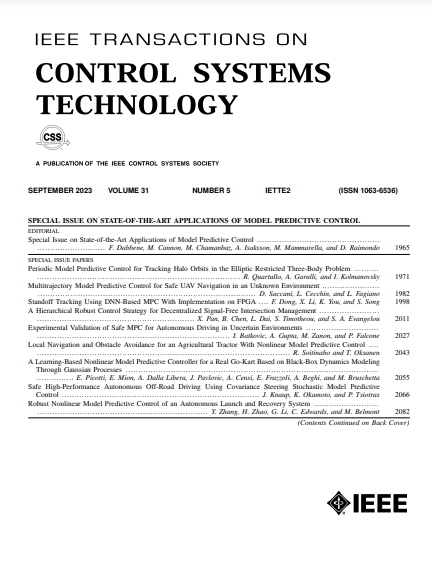
In a dynamic distribution market environment, residential prosumers with solar power generation and battery energy storage devices can flexibly interact with the power grid via power exchange. Providing a schedule for this bidirectional power dispatch can facilitate the operational planning for the grid operator and bring additional benefits to the prosumers with some economic incentives. However, the major obstacle to achieving this win–win situation is the difficulty in: 1) predicting the nonlinear behaviors of battery degradation under unknown operating conditions and 2) addressing the highly uncertain generation/load patterns, in a computationally viable way. This article thus establishes a robust short-term dispatch framework for residential prosumers equipped with rooftop solar photovoltaic (PV) panels and household batteries. The objective is to achieve the minimum-cost operation under the dynamic distribution energy market environment with stipulated dispatch rules. A general nonlinear optimization problem is formulated, taking into consideration the operating costs due to electricity trading, battery degradation, and various operating constraints. The optimization problem is solved in real-time using a proposed ensemble nonlinear model predictive control (EnNMPC)-based economic dispatch strategy, where the uncertainty in the forecast has been addressed adequately albeit with limited local data. The effectiveness of the proposed algorithm has been validated using real-world prosumer datasets.
Published in IEEE Transactions on Transportation Electrification, August 7, 2023 [FullText]
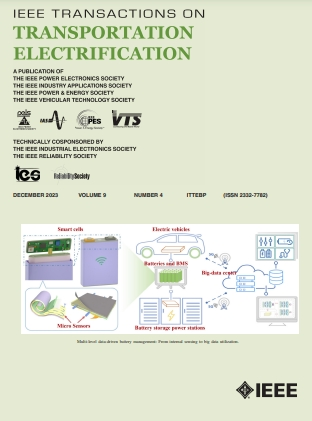
A battery management system (BMS) is essential for the safety and longevity of lithium-ion battery (LIB) utilization. With the rapid development of new sensing techniques, artificial intelligence, and the availability of huge amounts of battery operational data, data-driven battery management has attracted ever-widening attention as a promising solution. This review article overviews the recent progress and future trend of data-driven battery management from a multilevel perspective. The widely explored data-driven methods relying on routine measurements of current, voltage, and surface temperature are reviewed first. Within a deeper understanding and at the microscopic level, emerging management strategies with multidimensional battery data assisted by new sensing techniques have been reviewed. Enabled by the fast growth of big data technologies and platforms, the efficient use of battery big data for enhanced battery management is further overviewed. This belongs to the upper and macroscopic levels of the data-driven BMS framework. With this endeavor, we aim to motivate new insights into the future development of next-generation data-driven battery management.
Published in IEEE Transactions on Control Systems Technology, August 30, 2023 [FullText]
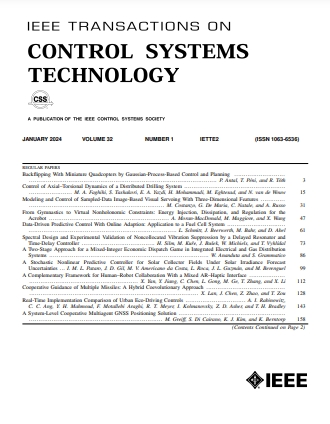
We propose a novel nonlinear control approach for fast charging of lithium-ion batteries, where health- and safety-related variables, or their time derivatives, are expressed in an input-polynomial form. By converting a constrained optimal control problem into an output tracking problem with multiple tracking references, the required control input, i.e., the charging current, is obtained by computing a series of candidate currents associated with different tracking references. Consequently, an optimization-free nonlinear model inversion-based control algorithm is derived for charging the batteries. We demonstrate the efficacy of our method using a spatially discretized high-fidelity pseudo-two-dimensional (P2D) model with thermal dynamics. Conventional methods require computationally demanding optimization to solve the corresponding fast charging problem for such a high-order system, leading to practical difficulties in achieving low-cost implementation. Results from comparative studies show that the proposed controller can achieve performance very close to nonlinear and linearized model predictive control but with much lower computational costs and minimal parameter tuning efforts.
Published in Fuel, August 31, 2023 [FullText]
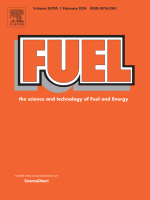
Proton exchange membrane fuel cell (PEMFC) models are conventionally established with a set of parameters identified under steady-state operating conditions. However, such an approach is insufficient to accurately capture the dynamic characteristics of multi-parameter changes in real-world scenarios. This paper develops a semi-empirical model for a 110-kW commercial PEMFC system based on its dynamic operation data to remedy the defects. To improve the fitting accuracy of the semi-empirical PEMFC model, an improved grey wolf optimization (IGWO) algorithm is proposed for model parameter identification. The IGWO algorithm adopts chaotic mapping to optimize the initial population distribution, and a random walk strategy is incorporated to boost the local search ability of the traditional grey wolf optimization (GWO) algorithm. The effectiveness of this IGWO algorithm in optimizing the semi-empirical model is experimentally verified on the 110-kW PEMFC system under highly dynamic operating conditions. Results show that the proposed IGWO algorithm can effectively identify the semi-empirical model’s parameters, establishing a stable and robust model that outperforms those based on traditional metaheuristic algorithms such as GWO, particle swarm optimization, and genetic algorithm. The demonstrated improvement renders it as better suited for optimizing PEMFC semi-empirical models under real-world operating conditions.
Published in IEEE Transactions on Energy Conversion, September 4, 2023 [FullText]
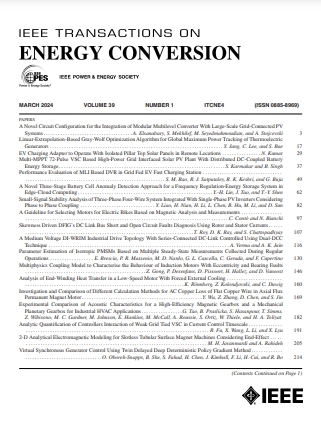
Predicting the degradation behaviors is challenging and essential for prognostics and health management for proton exchange membrane fuel cells (PEMFCs). However, existing methods based on data-driven or model-based methods can face the problem of significant performance inconsistencies in different prediction stages. We investigate the cause and attribute it to the ignorance of the voltage recovery phenomena of PEMFCs observed during the frequent start-stop processes during practical applications. A novel prognostic method is proposed to provide a more comprehensive analysis of PEMFC aging that integrates data-driven and model-based methods. Specifically, a physics-based aging model considering voltage recovery (PA-VR) is first reported as a model-based method to enhance the prediction effect at voltage mutation points. Then, the moving window method with iterative function is used to combine the data-driven method with the PA-VR model, which realizes the online update of model parameters. Finally, the weightings on individual approaches are dynamically determined at different stages throughout the PEMFC lifecycle. The proposed hybrid method achieves an effective improvement in prediction performance by combining the overall degradation trend predicted by the PA-VR model and the local dynamic characteristics predicted by the data-driven method.
Published in Applied Thermal Engineering, October 18, 2023 [FullText]
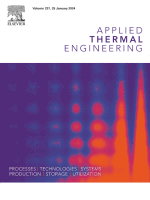
Enhancing thermoelectric performance hinges on optimizing the geometry of thermoelectric legs. In this study, we present a novel asymmetrical annular thermoelectric generator (ATEG) in which the proportions of P-type and N-type legs are meticulously balanced. We construct a one-dimensional analytical model tailored to this ATEG. Utilizing this model, we derive the relationship governing thermal-electrical impedance matching in an asymmetrical ATEG and formulate a general expression for optimizing the asymmetry coefficient. We explore the influence of various thermal boundary conditions on optimal impedance matching, ideal annular leg parameters, and the optimal asymmetry coefficient. Our findings reveal that thermal boundary conditions significantly affect the optimal load ratio. Furthermore, in comparison to traditional ATEGs, our proposed asymmetrical ATEG with the optimized structure exhibits a remarkable 16.2% increase in output power while maintaining the same material volume. Additionally, we perform a three-dimensional numerical analysis of the asymmetrical ATEG using Comsol. Our research findings indicate that introducing the asymmetric structure leads to higher maximum thermal stress on the legs. Interestingly, the study of asymmetric thermal boundary conditions highlights that improving heat transfer between the ATEG and the cooler yields higher mechanical reliability compared to enhancing heat transfer between the ATEG and the heat source.
Published in Journal of Energy Storage, November 7, 2023 [FullText]
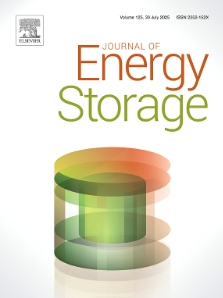
The vanadium redox flow battery (VRB) system involves complex multi-physical and multi-timescale interactions, where the electrolyte flow rate plays a pivotal role in both static and dynamic performance. Traditionally, fixed flow rates have been employed for operational convenience. However, in today’s highly dynamic energy market environment, adjusting flow rates based on operating conditions can provide significant advantages for improving VRB energy conversion efficiency and cost-effectiveness. Unfortunately, incorporating the electrolyte flow rate into conventional multi-physical models is overly complex for VRB management and control systems, as real-time operations demand low-computational and low-complexity models for onboard functionalities. This paper introduces a novel data-driven approach that integrates flow rates into VRB modeling, enhancing data processing capabilities and prediction accuracy of VRB behaviors. The proposed model adopts a gated recurrent unit (GRU) neural network as its fundamental framework, exhibiting exceptional proficiency in capturing VRB’s nonlinear voltage segments. The GRU network structure is carefully designed to optimize the predictive ability of the model, with flow rate considered as a crucial input parameter to account for its influence on VRB behavior. Model refinement involves analyzing well-designed simulation results obtained during VRB operations under various flow rates. Laboratory experiments were also designed and conducted, covering different conditions of currents and flow rates to validate the proposed data-driven modeling method. Comparative analyses were performed against several state-of-the-art algorithms, including equivalent circuit models and other data-driven models, demonstrating the superiority of the proposed GRU-based VRB model considering flow rates. Thanks to the GRU’s outstanding capability in processing time series data, the proposed model delivers impressively accurate terminal voltage predictions with a low error margin of no more than 0.023 V (1.3%) under wide operating ranges. These results indicate the efficacy and robustness of the proposed approach, highlighting the novelty and significance of accounting for flow rates in accurate VRB modeling for management and control system design.
Published in Renewable Energy, November 16, 2023 [FullText]
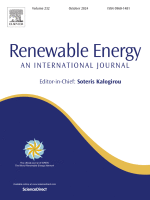
Enhancing thermoelectric performance while minimizing exhaust back pressure is a crucial step in advancing the commercial viability of automotive thermoelectric generators. To achieve high overall performance in a thermoelectric generator, an annular thermoelectric generator equipped with circular pin fins is proposed. A comprehensive three-dimensional numerical model is established to accurately predict thermoelectric performance and thermomechanical behavior. Detailed multi-physics field distribution characteristics are analyzed. Using an L25 orthogonal array, we examine five influencing factors and their five levels: exhaust temperature, exhaust mass flow rate, fin height, fin diameter, and the number of fins. The Taguchi analysis suggests that exhaust temperature is the most influential factor in determining thermoelectric performance, followed by mass flow rate, fin height, fin diameter, and fin number. The optimal values for these parameters are 673 K, 30 g/s, 20 mm, 3 mm, and 420, respectively. Under the optimal design parameters, the net power reaches 34.11 W, representing an 18.7% increase compared to the original design. Moreover, a comparative study is conducted between plate fins and pin fins, showing that the pin fin-based thermoelectric generator exhibits a 5.83% increase in output power and a 4.82% increase in maximum thermal stress compared to the plate fin-based thermoelectric generator.
Published in Energy Conversion and Management, November 16, 2023 [FullText]
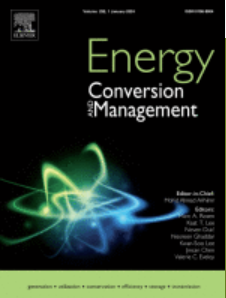
In integrated hydrogen energy utilization systems, due to the low efficiency of hydrogen/electricity conversion, coordination of energy management and efficient waste heat recovery is required to optimize performance. To address this challenge, this paper presents a comprehensive and sophisticated modeling and energy management strategy to enhance the off-grid energy utilization rate while prolonging the main components’ lifetime. The developed model incorporates multiphase flow and heat transport balance for electricity and heat production, enabling a highly accurate representation of real-world behaviors of the system. The proposed off-grid operation strategy is complemented by a designed heat recovery scheme, ensuring the use of energy resources and waste heat. In addition, the proposed energy management strategy monitors the real-time status of each subsystem, actively reducing the number of harmful start-stop cycles of the hydrogen production system, thereby mitigating short-term power impacts and delaying its aging. Specifically, the voltage degradation of the reduction cell is reduced from 4.67 mV to 4.48 mV, the energy utilization rate is increased from 47.6% to 53.9%, and the energy efficiency of fuel cells significantly increases from 53.6% to 78.1%.
Published in IEEE Transactions on Transportation Electrification, November 23, 2023 [FullText]
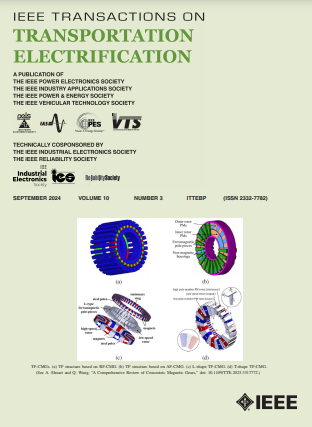
A prognostics and health management (PHM) system with prediction at its core optimizes the durability of the proton exchange membrane fuel cell (PEMFC). However, the aging behavior model has some uncertainty due to limited knowledge, affecting the predictive performance in remaining useful life (RUL) prediction. To address this issue, an RUL prediction method based on the Bayesian framework considering uncertainty quantification on the full-time scale is proposed. First, the state of health (SOH) of the PEMFC is estimated, and the behavior of uncertainty is quantified. Afterward, a long short-term memory (LSTM) neural network is employed to make a prediction for its behavior. Finally, the RUL of PEMFC is predicted based on historical SOH and the predicted behavior of uncertainty. Validation indicates that the proposed method can make a long-term prediction and provide RUL prediction with high accuracy. Under the dynamic operating condition, in terms of long-term prediction, compared to unscented Kalman filter (KF), adaptive unscented KF, double-input-echo-state-network, and bidirectional LSTM, the proposed method decreases the error by 88.12%, 41.99%, 13.82%, and 3.21%, respectively. Also, under dynamic operating conditions, the proposed method shows good stability. Moreover, the robustness of this method has also been verified.
Published in Applied Energy, March 23, 2024 [FullText]
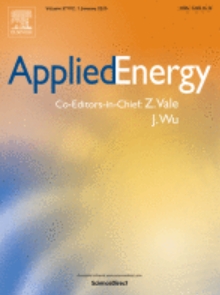
In recent years, considerable effort has been dedicated to the development of highly efficient thermoelectric generators for waste heat recovery and thermoelectric power generation. In this study, we present employing twisted tapes with variable twist ratio to enhance thermal energy extraction efficiency, coupled with two-stage thermoelectric modules for heat-to-electricity conversion, resulting in a substantial increase in the power output of the thermoelectric generator. We established an experimental system that validated the superior power generation and heat recovery characteristics of the two-stage thermoelectric generator. Building upon these findings, we propose further optimizing the variable twist ratio twisted tapes to enhance the power output. We investigated the impact of tape pitch ratio, twist ratio, and twist ratio variation range on thermoelectric performance. Experimental results indicate that the influence of flow instability is more pronounced than that of swirl intensity, and twist tapes with the maximum twist ratio variation rate yield the highest net output power. Compared to an unmodified thermoelectric generator, the two-stage thermoelectric generator employing twist tapes with a twist ratio increase from π to 3π achieves a maximum net output power gain of up to 100%. These findings provide a practical framework for integrating innovative power generation modules and optimized heat exchanger designs into the application of waste heat recovery thermoelectric generators, marking a significant advancement in the field of thermoelectric generators.
Published in International Journal of Hydrogen Energy, April 24, 2024 [FullText]
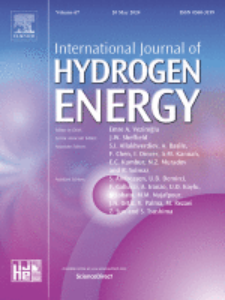
Hydrogen energy is recognized as a crucial solution for addressing energy crises and advancing energy conservation and emissions reduction. It will play a significant role in the future integrated energy systems (IESs). However, the influence of seasonal variations in scheduling optimization of hydrogen-integrated energy system has rarely been investigated. A low-carbon scheduling model for IES, adopting multiple demand responses and a ladder-type carbon trading mechanism, has been established. Additionally, a multi-time scale dispatch optimization strategy considering seasonal hydrogen utilization is thus proposed in this paper. Specifically, day-ahead scheduling optimizes the system taking into account the seasonal variations of renewable energy and load. In the intraday stage, rolling optimization is adopted to address the forecasting errors introduced by wind and photovoltaic fluctuations. In the real-time stage, chance-constrained methods are employed to ensure short-term supply-demand balance. The efficacy of the proposed strategy is verified using real-world measurements, and the results show the multi-time scale scheduling strategy and multiple demand responses effectively enhanced the system’s self-regulation capability, leading to a 12% increase in renewable energy absorption. In addition, seasonal hydrogen utilization is essential for system design, as it enhances the absorption of renewable energy, reducing the purchase cost by 4% and the total cost by 2.6%.
Published in IEEE Transactions on Transportation Electrification, May 10, 2024 [FullText]
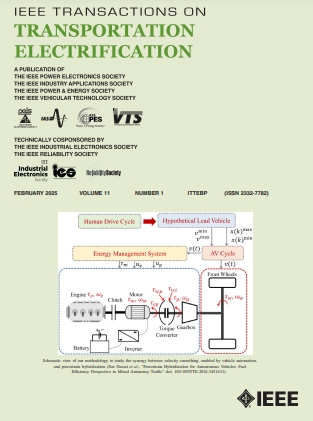
The capacity underutilization caused by cell inconsistency hinders the efficient utilization of lithium-ion battery packs. This is particularly critical for the second-life battery utilization where high cell inconsistency exists. To address this issue, this article proposes a multiscale reconfiguration control method enabled by an efficient reconfigurable battery topology, aiming to maximize the pack’s capacity utilization. In this regard, a novel four-switch reconfigurable battery topology is proposed, offering the advantages of all-cell flexibility and reasonable complexity. Building upon this, an all-cell equalization method is proposed, combining intramodule current sharing and three forms of intermodule energy distribution to achieve maximum pack capacity utilization. Moreover, real-time reconfiguration ensures effective charge transmission when the pack voltage deviates from the expected threshold. A laboratory-scale prototype of the reconfigurable battery pack is tested, and the experimental results confirm that the proposed design and reconfiguration control can improve pack capacity utilization and efficiency by 10.96% and 14.34%, respectively, without any redundant design. This method provides a feasible solution for grouping and system management of second-life battery systems consisting of highly inconsistent cells.
Published in IEEE Transactions on Energy Conversion, May 30, 2024 [FullText]
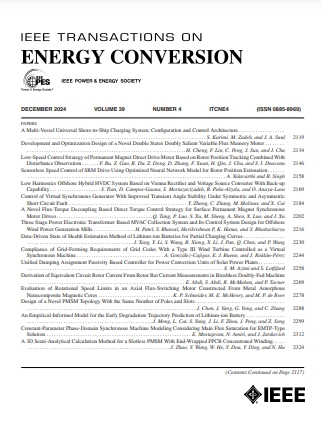
State of health (SOH) is one of the most important performance indicators of lithium-ion batteries (LIBs). Accurate estimation of SOH is a prerequisite for the safe and reliable operation of LIBs. Traditional SOH estimation methods predominantly rely on complete charging cycle data acquired through laboratory testing. However, in practical application, the charging behaviors of electric vehicle users are random and unpredictable, making the partial charging curves difficult to utilize the traditional methods. This work introduces a novel data-driven approach to estimating a battery’s SOH for partial charging cases. Firstly, a curve fitting method is proposed to extract health indicators (HIs) from partial charging voltage data, where novel HIs based on the energy-voltage curve are extracted. A composite Gaussian process regression-based data-driven method is proposed to achieve highly accurate SOH estimation. The method’s adaptability to real-world partial charging habits is evaluated through three representative scenarios derived from extensive charging behavior reports of EV users. The impact of partial charging on HI extraction is analyzed based on the three identified scenarios. The proposed method is verified using a combination of our laboratory testing data and the Oxford open dataset. The results show that the proposed framework demonstrates the ability to estimate SOH accurately and strong robustness to various partial charging behaviors.
Published in Energy, June 19, 2024 [FullText]
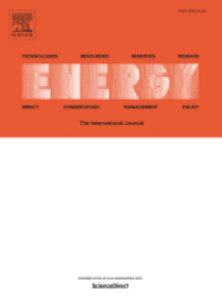
Frequency response analysis (FRA) methods are commonly used in the field of State of Health (SOH) estimation for Lithium-ion batteries (Libs). However, identifying their appropriate application scenarios can be challenging. This paper presents four FRA techniques, including electrochemical impedance spectra (EIS), mid-frequency and low-frequency domain equivalent circuit model (MLECM), distribution of relaxation time (DRT) and non-linear FRA (NFRA) technique. This paper proposes two estimation frameworks, machine learning and curve fitting, to be applied to each of the four techniques. Eight SOH estimation models are developed by linking the extracted feature parameters to the battery capacity variations. The paper compares the accuracy of estimation, estimation range, and other properties of the eight models. Application scenarios are identified for the techniques by using three classification methods: different estimation frameworks, frequency response linearity, and impedance technique. The results demonstrate that MLF is recommended for scenarios with a large amount of battery data, while CFF is recommended for scenarios with a small amount of data. NFRA could be applied to electric vehicle power batteries, while LFRA is recommended to be used for retired batteries. EIS method is recommended for complex and dynamic scenarios, while non-EIS method is recommended for scenarios that require high accuracy.
Published in Journal of Energy Storage, June 28, 2024 [FullText]
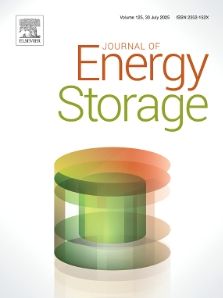
In an integrated hydrogen energy utilization system, the hydrogen storage device needs to meet hydrogen supplies and demands of different pressure levels, traditional hydrogen storage systems will lead to more energy consumption and lower hydrogen supply efficiency. To address this problem, a cascade hydrogen storage system (CHSS) is proposed in this study. By configuring three hydrogen storage tanks (HSTs) with three pressure levels, the CHSS is capable of serving hydrogen for fuel cell supply, long-term storage, and refueling stations. The corresponding control strategy of hydrogen flow between HSTs is proposed. It shows that an optimal capacity configuration scheme with pressures of 3 MPa, 24.44 MPa, and 45 MPa and a hydrogen storage capacity of 401.7 kg, optimized by NSGA-II, can meet the stable operation of the system. Comparative studies show that the proposed CHSS configuration can reduce the cost by about 3.78%, the energy consumption by about 6.92%, and the hydrogen supply loss rate by about 12% compared to the existing solutions under the tested conditions.
Published in Renewable Energy, July 23, 2024 [FullText]
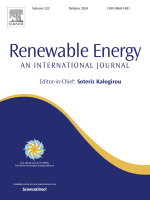
The utilization of metal foam for heat transfer augmentation is regarded as a highly efficient technique, albeit associated with significant pressure losses. To enhance the feasibility of employing metal foam in thermoelectric generators and mitigate the high-pressure drop, we propose an enhancement strategy involving the partial axial filling of gradient metal foam. Both analytical modeling and experimental investigation were employed to evaluate the effects of porosity, pore density, and gradient structure at various filling rates on the overall performance of thermoelectric generators. The results show that arranging metal foam with increasingly high frame density in the direction of fluid flow, rather than adopting increasingly sparse or constant structures, leads to improved voltage uniformity and reduced pressure drop. A positive gradient configuration with a pore density distribution of 5-10-20 PPI yielded the highest net power at 118.3 W, which is 12.5% higher than that of metal foam with constant 20 PPI. Ultimately, empirical verification substantiates the comprehensive performance advantages of positive gradient configuration. For filling rates of 30%, 60%, and 100%, pressure drop is reduced by 35.9%, 33.4%, and 29.2%, respectively, in comparison to constant 20 PPI metal foam, despite a modest reduction in output power, which remains less than 3%.
Published in Energy, August 20, 2024 [FullText]
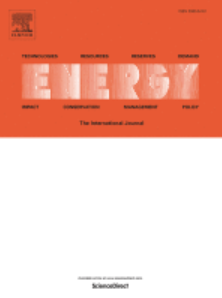
The typical Integrated Hydrogen Energy Utilization System (IHEUS) does not recycle oxygen. For maximizing the system’s efficiency, this study proposes a method for recycling byproduct oxygen in a Fuel Cell (FC) hybrid cathode intake structure and its control. By introducing the pure oxygen produced as a byproduct of hydrogen production into the FC, a hybrid cathode intake structure is formed with the air branch. To control this structure, models of the oxygen and air branch, and the FC stack are established. Subsequently, using BiLSTM network to learn historical data and extract relevant features, the output power demand of the FC system is predicted. Based on the prediction results, the required gas flow is calculated, and a fuzzy PID control strategy is employed to adjust the opening of the solenoid valve to change the gas flow to meet the demand. Finally, comparative studies show that our FC system, operating in a pure oxygen state, outperforms conventional air intake design: heat production increases by 13%, electric efficiency improves by 20%, and pure water savings reach 65.57 %. The air compressor witnesses a substantial 37.63% reduction in power consumption, contributing to an overall energy efficiency increase of 8.92% for the IHEUS.
Published in IEEE Transactions on Pattern Analysis and Machine Intelligence, September 9, 2024 [FullText]
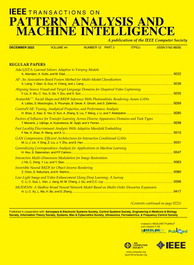
The concept of integrating physics-based and data-driven approaches has become popular for modeling sustainable energy systems. However, the existing literature mainly focuses on the data-driven surrogates generated to replace physics-based models. These models often trade accuracy for speed but lack the generalizability, adaptability, and interpretability inherent in physics-based models, which are often indispensable in modeling real-world dynamic systems for optimization and control purposes. We propose a novel machine learning architecture, termed model-integrated neural networks (MINN), that can learn the physics-based dynamics of general autonomous or non-autonomous systems consisting of partial differential-algebraic equations (PDAEs). The obtained architecture systematically solves an unsettled research problem in control-oriented modeling, i.e., how to obtain optimally simplified models that are physically insightful, numerically accurate, and computationally tractable simultaneously. We apply the proposed neural network architecture to model the electrochemical dynamics of lithium-ion batteries and show that MINN is extremely data-efficient to train while being sufficiently generalizable to previously unseen input data, owing to its underlying physical invariants. The MINN battery model has an accuracy comparable to the first principle-based model in predicting both the system outputs and any locally distributed electrochemical behaviors but achieves two orders of magnitude reduction in the solution time.
Published in iScience, September 16, 2024 [FullText]

Efficient health indicators (HI) and prediction methods are crucial for assessing the remaining useful life (RUL) of fuel cells. However, obtaining HI under dynamic conditions with frequently changing loads is highly challenging. Therefore, this study proposes a prediction framework based on dynamic conditions. A method combining complete ensemble empirical mode decomposition with adaptive noise, power spectral density, and energy analysis (CPE) is proposed to extract HI under dynamic conditions from the perspectives of frequency and energy. Furthermore, the time convolution network with adaptive Bayesian optimization (AB-TCN) is introduced to address parameter optimization and prediction challenges. Effective feature parameters of the data are identified using random forest and used to train the AB-TCN. Results show that the extracted HI can effectively determine the end-of-life. The AB-TCN achieves accurate RUL estimation with a prediction error of only 6.825% and shows strong adaptability to various prediction tasks.
Published in Applied Energy, October 11, 2024 [FullText]
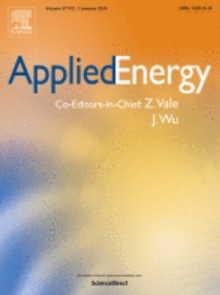
The proton exchange membrane electrolyzer (PEMEL) system offers significant advantages for utilizing renewable energy for hydrogen production, owing to its high efficiency and wide operating range. However, the current research mainly focuses on optimizing the stack and overlooking the modeling of nonlinear behavioral characteristics and sensitivity analysis related to the dynamics of the mass and energy transfer process at the system level. Thus, this paper proposes a method for dynamically modeling and conducting multivariate parameter sensitivity analysis of the PEMEL hydrogen production system, considering the mass-energy equilibrium. Temperature, pressure, water discharge, and other factors are integrated to model the PEMEL hydrogen production system based on the Balance of Plant (BoP). System efficiency, system power, and power consumption per unit of hydrogen production are utilized as performance indicators. To verify the model’s feasibility, the output characteristics were compared with the experimental results from both stack and system levels, yielding a Coefficient of Determination (R-squared) exceeding 97%, which indicates a strong fit between simulation and reality. Subsequently, three sensitivity analysis methods, Taguchi method, analysis of variance (ANOVA), and Pareto analysis, were employed to determine the contribution of different parameters to the key system performance indicators and identify the optimal operating combination. Orthogonal arrays and signal-to-noise ratio (SNR) analysis facilitated this assessment. Results reveal that the operating temperature had the highest contribution to system efficiency and power consumption per unit of hydrogen production, reaching 69.48% and 70.09%, with the standardized effect far exceeding the minimum threshold of 2.069. Pressure holds the highest influence on the system power, at 77.98%. Finally, within the operational feasibility domain of the system, the calculation ensured that power consumption per unit of hydrogen production remains below 4.7 kW·h/m3.
Published in IEEE Transactions on Control Systems Technology, November 20, 2024 [FullText]
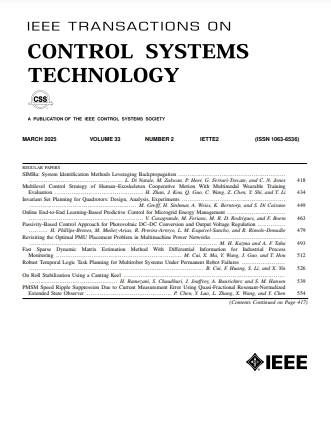
Lithium-ion battery packs demand effective active equalization systems to enhance their usable capacity and lifetime. Despite numerous topologies and control schemes proposed in the literature, conducting quantitative analyses, comprehensive comparisons, and systematic optimization of their performance remains challenging due to the absence of a unified mathematical model at the pack level. To address this gap, we introduce a novel, hypergraph-based approach to establish the first unified model for various active battery equalization systems. This model reveals the intrinsic relationship between battery cells and equalizers by representing them as the vertices and hyperedges of hypergraphs, respectively. With the developed model, we identify the necessary conditions for all equalization systems to achieve balance through controllability analysis, offering valuable insights for selecting the number of equalizers. Moreover, we prove that the battery equalization time is inversely correlated with the second smallest eigenvalue of the hypergraph’s Laplacian matrix of each equalization system. This significantly simplifies the selection and optimized design of equalization systems, obviating the need for extensive experiments or simulations to derive the equalization time. Illustrative results demonstrate the efficiency of the proposed model and validate our findings.
Published in IEEE Transactions on Transportation Electrification, March 26, 2025 [FullText]
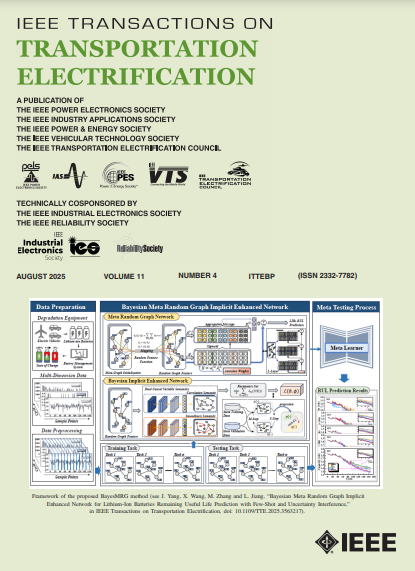
Existing methods for estimating the state of health (SOH) of lithium-ion battery (LIB) rely typically on the assumption that the distribution of noise (or outliers) in the measurement data is known. This assumption, however, rarely holds true for LIB operating under real-world conditions. This article proposes a stable framework for accurate SOH estimation that accommodates noises with unknown distribution in both measurement data and label values. The framework combines generalized correntropy loss (GCL) with Savitzky-Golay (SG) filter and extreme learning machine (ELM) to obtain measurement data filter named SG filter with GCL (SG-GCL) and SOH estimator named generalized ELM (GELM), respectively. The SG-GCL filtering of the measurement data keeps the root-mean-square error (RMSE) within 0.0365%, and Pearson correlation between extracted feature and SOH improves by 0.4963, which, in turn, leads to the reduction of the RMSE metrics of the ELM for the estimation of the SOH by 43.69%. From the filtering results, feature extraction and estimation results proved its necessity and effectiveness. GELM effectively suppresses the influence of label value noise on the model in the training process, which reduces the SOH estimation RMSE index by more than 0.66%. The results from experiments with different distributional noise conditions show that the proposed SOH estimation framework has excellent and stable performance.
Published in Green Energy and Intelligent Transportation, March 27, 2025 [FullText]
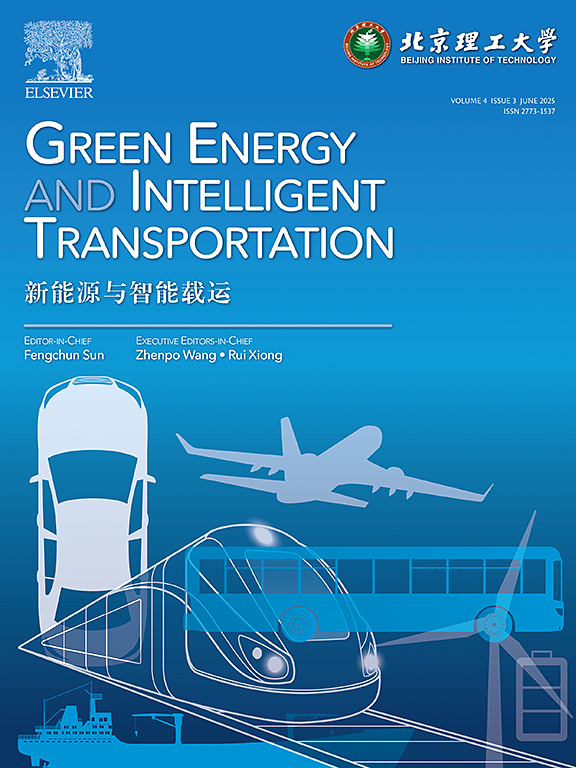
Accurately predicting the degradation trends of proton exchange membrane fuel cells (PEMFCs) can provide a solid basis for optimizing the control of vehicles and stations based on PEMFCs. However, most prediction methods do not consider factors such as measurement errors from experimental environments and the inherent cognitive uncertainty of the model. These methods can only offer point estimates, lacking credibility. This paper introduces a deep learning prediction framework that combines a bidirectional gated recurrent unit (BiGRU) model with a truncated Bayes by backpropagation through time (TB) algorithm. The TB algorithm reconstructs fixed parameters in the model into probability density distributions, transforming the output from point estimation to interval estimation with probability density distributions. Under dynamic conditions, the TB-BiGRU (truncated Bayes-based bidirectional gated recurrent unit) improves the mean absolute error (MAE) and root mean square error (RMSE) by 37.28% and 36.09%, respectively, compared to the TB-GRU (truncated Bayes-based gated recurrent unit). Compared with TB-GRU and B-GRU (Bayesian gated recurrent unit), TB-BiGRU has significantly improved uncertainty quantification ability. Under different working conditions and noise levels, the prediction accuracy of TB-BiGRU is superior to that of the other seven models, and it exhibits better noise resistance and stability. This method holds greater practical significance compared to other prediction approaches. Additionally, the paper proposes four effective evaluation metrics for uncertainty quantification, providing higher reference value in effectively characterizing the model’s prediction accuracy and uncertainty quantification capability.
Published in IEEE Open Journal of Vehicular Technology, April 9, 2025 [FullText]
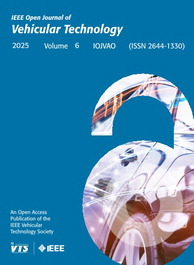
The increasing penetration of electric vehicles (EVs) presents a significant challenge for power grid management, particularly in maintaining network stability and optimizing energy costs. Existing model predictive control (MPC)-based approaches for EV charging and discharging scheduling often struggle to balance computational efficiency with real-time operationability. This gap highlights the need for more advanced methods that can effectively mitigate the impact of EV activities on power grids without oversimplifying system dynamics. Here, we propose a novel scheduling methodology using a pre-trained Reinforcement Learning (RL) framework to address this challenge. The method integrates real grid simulations to monitor critical electrical points and variables while simplifying analysis by excluding the influence of real grid dynamics. The proposed approach formulates the scheduling problem to minimize costs, maximize rewards from ancillary service delivery, and mitigate network overloads at specified grid nodes. The methodology is validated on a benchmark electric grid, where realistic charging station utilization scenarios are simulated. The results demonstrate the method’s robustness and ability to efficiently cope with the EV smart scheduling problem.
Published in Energy Conversion and Management: X, April 15, 2025 [FullText]
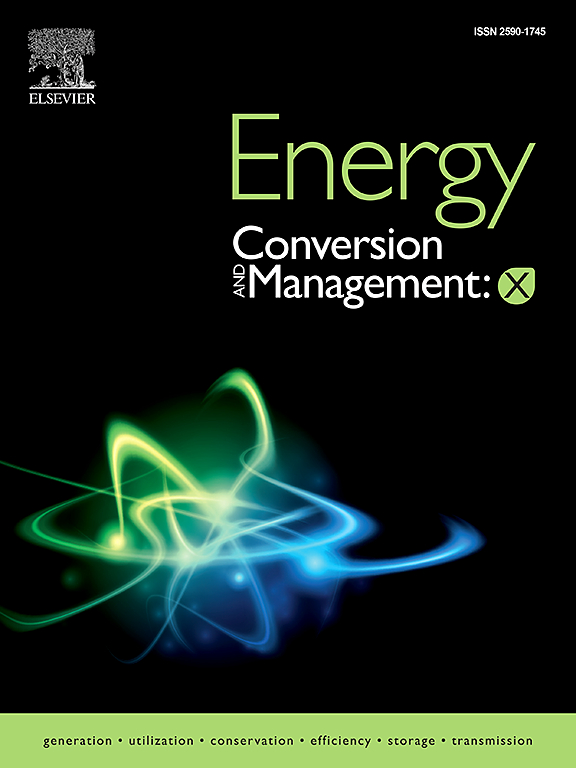
Hydrogen energy storage (HES) systems could balanced source-load mismatches in DC microgrids. By combining HES with electrical energy storage (EES), the start-up delay and rapid degradation of HES under fluctuating inputs can be mitigated, enhancing system adaptability. However, without proper power allocation and operational optimization, system efficiency and the lifespan of HES and EES decrease. Accordingly, this paper proposes a compatible matching and synergy operation optimization for hydrogen-electric hybrid energy storage systems (H-E HESS). Firstly, Complete Ensemble Empirical Mode Decomposition with Adaptive Noise (CEEMDAN) is developed to decompose power fluctuation signals into frequency components, and the Hilbert transform calculates the energy value to determine high- and low-frequency dividing points. Next, a system power allocation strategy is formulated through the fast response of the EES to compensate for the delay in the start-up of the HES. A multi-objective optimization model is then developed to balance efficiency and lifespan, which is solved by the NSGA-III algorithm. Finally, case studies show that the proposed strategy improves efficiency by 17.95% and 8.34%, reduces degradation rates by 1% and 0.71%, and shortens system response time in 1 s, compared to Schemes I and II. The strategy’s effectiveness is also validated through an experimental platform in a hydrogen-electric coupled DC microgrid demonstration project.
Published in IEEE Journal of Emerging and Selected Topics in Industrial Electronics, April 16, 2025 [FullText]
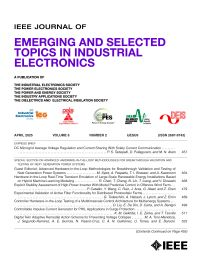
Accurately predicting the remaining useful life (RUL) of lithium-ion batteries is crucial to ensure the safe and reliable operation of the energy storage and power supply systems. However, RUL prediction is significantly affected by the challenges posed by multi-dimensional nonlinearity. Embedding spatial-temporal variables helps reveal nonlinear relationships, making the degradation capacity spatial-temporal embedding an effective approach for extracting patterns and trends of battery degradation within multi-dimensional subspaces. Motivated by this, this work proposes a phase space reconstruction (PSR) approach that utilizes the C-C method combined with a convolutional neural network-bidirectional LSTM and hyperspace attention mechanism (CNN-BiLSTM-HAM) to address this challenge. First, the C-C method performs PSR according to time delay and embedding dimension values to transform degradation capacity data from one-dimensional time series into a multi-dimensional format. Next, the reconstructed capacity matrix is processed by the CNN to generate feature vectors that preserve the spatial structure and location information of the input data, while discarding irrelevant information. These feature vectors serve as input for training the BiLSTM. Finally, the HAM is used to allocate the weights of different feature subsets simultaneously. The proposed CNN-BiLSTM-HAM model and C-C method are validated using the NASA dataset. Experimental results demonstrate that the proposed method yields accurate RUL prediction, with the absolute error, mean absolute error, and root mean square error all being less than 2, 1.3%, and 2%, respectively.
Published in Chemical Engineering Journal, June 17, 2025 [FullText]
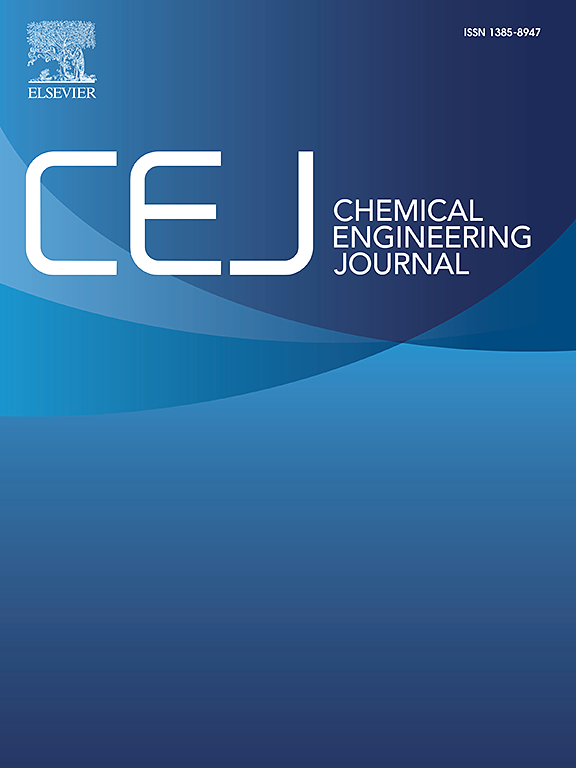
In multi-stack vanadium redox flow battery (VRB) modules, transport delays caused by variations in pipe structure and length can lead to imbalanced electrolyte distribution, higher efficiency losses, and reduced capacity utilization compared to single-stack systems. These limitations pose significant challenges to the scalability of VRBs for grid-scale energy storage. In this paper, we present a systematic study of various multi-stack VRB module configurations using a high-fidelity model that explicitly incorporates transport delays. A total of 208 multi-stack configurations are categorized and analyzed based on two key factors: pipe connections and electrical connections. Pipe connections include T-shape pipe flowing through the stack (T-shaped) and positive and negative tanks on the same side (same-side), cross-shape pipe flowing through the stack (cross-shaped) and positive and negative tanks on the opposite side (opposite-side), T-shaped opposite-side, cross-shaped same-side. Electrical connections include series, parallel, and mixed layouts. Simulation results identify the cross-shaped opposite-side pipe connection as optimal in terms of both capacity utilization and energy efficiency. Among electrical layouts, a 3p2s configuration (three stacks in parallel × two stacks in series) demonstrates the best system-level performance. The study further explores the impact of different initial states of charge and operating temperatures. In addition, an in-depth techno-economic assessment is performed to evaluate the practical feasibility of all considered configurations. By explicitly integrating transport delay dynamics, the proposed modeling framework enhances the predictive accuracy of VRB system performance. The findings provide quantitative insights for the design and optimization of scalable, high-efficiency multi-stack VRB systems suitable for grid-scale deployment.
Published in Advanced Science, July 27, 2025 [FullText]

Accurate state of health estimation is crucial for the reliable operation of lithium-ion batteries in electric vehicles. The charging curve contains valuable features for health evaluation, but real-world charging often lacks sufficient data due to the users’ early recharging habits. A smart method is proposed for accurate battery health estimation using super-short charging segments. This method combines a degradation mechanism-guided Scale-Invariant Feature Transform for smart health feature identification with machine learning for health evaluation. Validation with 87 batteries with various chemistries, formats, and capacities from 6 manufacturers demonstrates its efficacy. Regardless of battery specifications, health features can be identified automatically from the charging data. The method promises high accuracy (estimation error as low as 1.97%) even with super-short charging covering 10% state of charge span, where all the existing health feature extraction approaches fail. This method provides new avenues for battery health evaluation in uncertain real-world electric vehicle applications.
Published in Journal of Power Sources, October 18, 2025 [FullText]
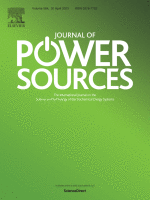
This paper presents a novel algorithmic framework for efficiently solving the pseudo-two-dimensional (P2D) model of lithium-ion batteries. The proposed approach reformulates the original P2D model, typically expressed as a system of coupled nonlinear partial differential–algebraic equations, into a system of quasilinear partial integro-differential equations (PIDEs). Through this reformulation, intermittent algebraic states, such as local potential and current terms, are effectively eliminated, thereby reducing the model complexity. This enables the identification of a generic fixed-point iterated function for solving the P2D model’s nonlinear algebraic equations. To implement this iterated function, the finite volume method is employed to spatially discretize the PIDE system into a system of ordinary differential equations. An implicit–explicit (IMEX) time integration scheme is adopted, and the resulting quasilinear structure facilitates the development of a single-step numerical integration scheme that admits a closed-form update, providing stable, accurate, and computationally efficient solutions. Unlike traditional gradient-based approaches, the proposed framework does not require the Jacobian matrix and is insensitive to the initial guess error of the solution, making it easier to implement and more robust in practice. Due to its significantly reduced computational cost, the proposed framework is particularly well-suited for simulating large-scale battery systems operated under advanced closed-loop control strategies.
Published in Journal of Energy Storage, October 24, 2025 [FullText]
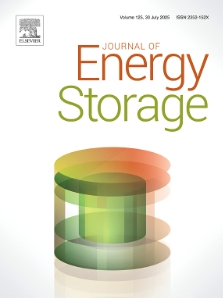
Vanadium redox flow batteries (VRBs) are promising for large-scale energy storage, yet their long-term performance is often compromised by electrolyte volume imbalances induced by ion migration and self-discharge. Existing flow rate control strategies have primarily focused on enhancing system efficiency, often at the expense of capacity retention and system stability. In this work, we propose a novel flow control strategy that integrates asymmetric and variable flow-rate control strategies to dynamically counteract electrolyte migration during cycling. This asymmetrical variable flow-rate (AVF) strategy is supported by a high-fidelity VRB model developed based on Darcy’s law, which characterizes electrolyte volume variations by incorporating the effects of viscosity, flow rate, and migrated electrolyte volume. With this model, a direct link is established between the state of charge and electrolyte viscosity. We then formulate and solve a constrained optimization problem using a heuristic approach to achieve adaptive flow regulation. Experimental validation demonstrates that the proposed AVF control strategy outperforms existing strategies by significantly reducing electrolyte migration, increasing discharge capacity, and slowing capacity degradation, which offers a practical pathway to enhance VRB longevity and efficiency.
Published in Energy, December 29, 2025 [FullText]
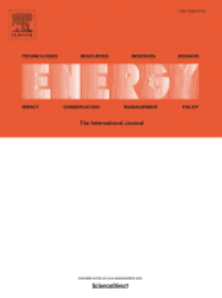
Current transfer learning-based methods for predicting the degradation of proton exchange membrane fuel cells (PEMFCs) commonly face insufficient elimination of inter-domain distribution shifts and low knowledge transfer efficiency. Traditional approaches typically extract domain-invariant features by filtering multi-dimensional operational parameters. This process is not only complex but may also introduce interference weakly correlated with voltage degradation, thereby compromising the stability and reliability of cross-domain predictions. To address these challenges, this paper proposes a time-frequency fusion transfer learning (TF-TL) architecture. Unlike existing methods that filter domain-invariant features from multi-dimensional operational parameters, the proposed approach directly aligns domains by leveraging the intrinsic frequency-domain characteristics of voltage signals. The integrated Frequency Domain Adaptation (FDA) technique employs Fast Fourier Transform (FFT) to extract intrinsic low-frequency components from voltage signals. It then aligns features between source and target domains using an enhanced Maximum Mean Discrepancy (MMD) metric. This voltage-centric, frequency-domain alignment avoids dependence on complex auxiliary parameters, thus improving the interpretability and stability of transfer learning. Experimental results show that TF-TL significantly improves generalization across devices and operating conditions, with FDA effectively reducing inter-domain distribution divergence. In multiple transfer tasks, the framework achieves highly accurate and reliable remaining useful life estimation with a relative error below 1.9%. The proposed architecture provides a theoretical foundation for deploying rapid and reliable online prognostic systems for PEMFCs under complex operating conditions.
Published:

We propose a novel fast-charging control framework for lithium-ion (Li-ion) batteries that can leverage a class of models including the high-dimensional, electrochemical-thermal pseudo-two-dimensional model. The control objective is to find the highest battery current while fulfilling various operating constraints. Conventionally, computationally demanding optimization is needed to solve such a constrained optimal control problem when an electrochemical-thermal model is used, leading to practical difficulties in achieving low-cost implementation. Instead, this paper provides an optimization-free solution to Li-ion battery fast charging by converting the constrained optimal control problem into an output tracking problem with multiple tracking references. The required control input, i.e., the charging current, is derived by inverting the battery model. As a result, a nonlinear inversion-based control algorithm is obtained for Li-ion battery fast charging. Results from comparative studies show that the proposed controller can achieve performance close to nonlinear model predictive control but at significantly reduced computational costs and parameter tuning efforts.
Undergraduate course, University 1, Department, 2014

This is a description of a teaching experience. You can use markdown like any other post.
Workshop, University 1, Department, 2015

This is a description of a teaching experience. You can use markdown like any other post.